2011 Wildlife Archives: Incredible Findings and Photos
Please read over our past months of great sightings. We welcome your questions about our beautiful island. We would also love to hear from you! Get outside and share your photos and stories with us at!
December 19, 2011 ~ American Alligator (Alligator mississippiensis)
At 1300 hours, the Hunt-Thomas Clan and I left from Eco under ominous skies towards uncharted destiny. As always no alligators were spotted in the first pond on the left, however slides are increasingly evident so activity is occurring. The boardwalk to the first pond has several vines of Toxicodendron radicans (as you know) and the autumnal frondescence has turned several lovely shades of brown, yellow and orange. After a brief and unsuccessful romp through the boscage of the swamp forest, the alligators were spotted on the golf course side of the second pond and were clearly visible from the enclave shore which has been significantly trimmed back. The large male was close to the bridge on the aforementioned shore and the female was less than 40 yards away towards the swamp forest. Two juvenile alligators were spotted in their usual spot near the entrance to the swamp forest on the golf course side, both juveniles are now about as large as #4 in the nature center. Bird activity was outstanding as always with a belted kingfisher continually diving on the pond, over and out.
Species Encountered: American alligator, Gallinule, Coot, Unidentified raptor (either sharp-shinned or cooper’s hawk), Black-crowned night heron, Belted Kingfisher, Great Egret (the largest one I’ve ever seen), Carolina Chickadee, Yellow bellied slider
November 20, 2011 ~ Fin and Feather Report
The dolphin activity was vibrant this afternoon after a relatively “quiet”, but very pleasing excursion this morning. We left the dock, at high tide, around 3:00 pm. We witnessed a lot of “playing”, approximately 50 to 75 feet away from the boat, by a very large solitary dolphin as we slowly passed the entrance to Oyster Creek. This lasted for about 5 minutes and was a lot of fun to watch. We slowly continued to Captain Sam’s Inlet where at least 8 dolphin were present. At the inlet, many dolphin were feeding with tails violently flapping and slapping fish, while others “dove” in and out of the water very near the boat. As always, the motor was in neutral as a precaution. An osprey hunted for its prey, forever, on the Kiawah side of the inlet- as cormorants, brown pelicans, terns and gulls rested on the Seabrook side of the inlet. After watching the osprey hunt, my guests asked if we could please look for bald eagles. So . . . I took them to Long Island (Seabrook) where I have seen, on previous trips, eagles perching and soaring along the tree line. No luck. We continued to towards Mingo Point with a brief stop at Andell Island with the hope of seeing a bald eagle. No luck. We returned to the Mingo Point dock very satisfied with our Dolphin Encounters trip. As I was unlocking the gate to the dock, two mature bald eagles were soaring together about 200 feet above and away from the dock, from the north- towards the Kiawah Bridge; bold white heads and white bottoms! We watched them as they flew away towards Snake Island, and presumably to their seasonal home on Andell. The trip could not have been more complete. No Way.
Brad Schmoll, Naturalist
November 17, 2011 ~ American Alligator
Two yearling alligators and big male gator were spotted this afternoon in the Enclave at Turtle Point pond during a Gator Walk tour. This pond has been an excellent wildlife spot lately, with plenty of waterbirds, gators, dragonflies, turtles, and even a few singing frogs.
William Oakley, Naturalist
November 10, 2011 ~ American Coot (Aythya affinis)
American Coots have arrived on Kiawah Island! Later in the winter, Willet and Ibis ponds typically harbor plenty of coots, but lately they’ve been hanging out with the Pied-billed Grebes in the pond by the Enclave at Turtle Point.
William Oakley, Naturalist
November 9, 2011 ~ Bat sp.
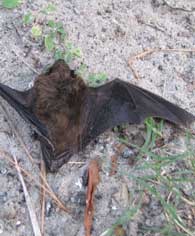 Today, Kiawah Naturalists removed a small group of bats from inside our maintenance building. After a quick inspection to ensure their health, all were released back into the wild.
Today, Kiawah Naturalists removed a small group of bats from inside our maintenance building. After a quick inspection to ensure their health, all were released back into the wild.
November 8, 2011 ~ Lesser Scaup (Aythya affinis)
Town Biologists reported the first groups of scaup today. A total of approximately 200 Lesser Scaup were seen flying over the ocean near the Beach Club. Numbers of scaup will increase dramatically over the next month and we typically have several thousand that winter off our beach.
November 1, 2011 ~ Scarlet Sanke (Cemophora coccinea)
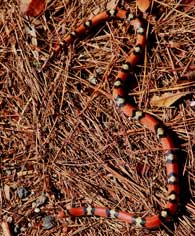 When looking for wildlife, one place we often forget to look is down. Beneath our feet is a whole world of creatures big and small; worms, insects, mammals, and of course reptiles. Reptiles that live in or beneath the soil are usually referred to as fossorial. One of the most infamous fossorial snakes, once known to inhabit our area is the dreaded, exaggeratedly dangerous, coral snake. The coral snake, thought to be extirpated, is most likely no longer in the area, but a few good imitators remain.
When looking for wildlife, one place we often forget to look is down. Beneath our feet is a whole world of creatures big and small; worms, insects, mammals, and of course reptiles. Reptiles that live in or beneath the soil are usually referred to as fossorial. One of the most infamous fossorial snakes, once known to inhabit our area is the dreaded, exaggeratedly dangerous, coral snake. The coral snake, thought to be extirpated, is most likely no longer in the area, but a few good imitators remain.
While moving soil behind East Beach Conference Center, Philip Zellner, Director of Resort Landscaping, came upon one such imitator, the scarlet snake (photo). Scarlet snakes are a harmless coral snake mimic that spend much of their life underground. These snakes feed primarily on other reptile eggs, and when handled, rarely bite and often do their best to escape human contact. Similar in coloration to the more popularly known Scarlet Kingsnake, its’ rings of red, black, and cream cease as they approach the belly (unlike the Scarlet Kingsnake, whose rings continue around the body.) If you come across one of these gems while digging in your garden, be assured it’s not a coral snake by remembering the simple rhyme, ”Red on yellow, kill a fellow. Red on black, good day for Jack.”
Michael Frees, Naturalist
October 31, 2011 ~ Loggerhead Sea Turtle (Caretta caretta)
2011 Loggerhead Turtle nesting map. Click on the nest markers for additional information on the nest, including: date, number of eggs, hatch date, and nesting success.
October 30, 2011 ~ Merlin (Falco columbarius)
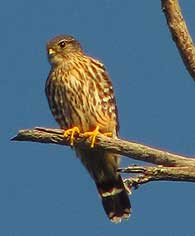 This photograph of a Merlin was taken by Naturalist William Oakley at Night Heron Park. Merlins are small American falcons that breed in open coniferous forests and prairies of Alaska, Canada, and northern parts of the western United States. Merlins and other American falcons can be spotted regularly (with some skill and luck) during autumn months on Kiawah Island.
This photograph of a Merlin was taken by Naturalist William Oakley at Night Heron Park. Merlins are small American falcons that breed in open coniferous forests and prairies of Alaska, Canada, and northern parts of the western United States. Merlins and other American falcons can be spotted regularly (with some skill and luck) during autumn months on Kiawah Island.
When/where to look for falcons on Kiawah: Sept- November; exposed perches near dunes, parks, and golf course edges; flying over dunes; Peregrines will chase roosting shorebirds at east and west ends of island.
October 29, 2011 ~ Green Oyster Worm (Phyllodoce fragilis)
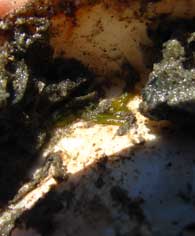 Prying open the tightly shut valves of live Eastern Oysters can yield amazing results, as Naturalist William Oakley discovered this past week after opening an oyster shell along the Kiawah River. In the place of a live oyster were two very small, green worm-like creatures slithering around inside the oyster shell. The animals, it turns out, are called Green Oyster Worms (Phyllodoce fragilis), and they live around clusters of Eastern Oysters where they presumably feed on small polychaete worms. Not much is known about these strange worms’ biology, but when disturbed, the Green Oyster Worm secretes a mucus containing a toxic substance that deters predators.
Prying open the tightly shut valves of live Eastern Oysters can yield amazing results, as Naturalist William Oakley discovered this past week after opening an oyster shell along the Kiawah River. In the place of a live oyster were two very small, green worm-like creatures slithering around inside the oyster shell. The animals, it turns out, are called Green Oyster Worms (Phyllodoce fragilis), and they live around clusters of Eastern Oysters where they presumably feed on small polychaete worms. Not much is known about these strange worms’ biology, but when disturbed, the Green Oyster Worm secretes a mucus containing a toxic substance that deters predators.
October 26, 2011 ~ Barred Owl
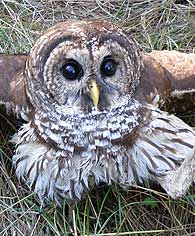 During today’s bird banding session on Captain Sam’s Spit, Assistant Town Biologist Aaron Given and Resort Naturalist William Oakley were absolutely stunned when they discovered a Barred Owl in one of the mist nets. A Gray Catbird in the net clued the researchers in on the Barred Owl’s intentions. Apparently, the owl was trying for an easy snack and ended up entangling itself in the fine, nylon mesh of the mist net. Before causing the owl any more stress, and possibly receiving razor-sharp talons in their hands, both Aaron and William decided to release the Barred Owl on the spot.
During today’s bird banding session on Captain Sam’s Spit, Assistant Town Biologist Aaron Given and Resort Naturalist William Oakley were absolutely stunned when they discovered a Barred Owl in one of the mist nets. A Gray Catbird in the net clued the researchers in on the Barred Owl’s intentions. Apparently, the owl was trying for an easy snack and ended up entangling itself in the fine, nylon mesh of the mist net. Before causing the owl any more stress, and possibly receiving razor-sharp talons in their hands, both Aaron and William decided to release the Barred Owl on the spot.
Small raptors are not unusual to capture during passerine banding, as trapped and exposed song birds in mist nets make easy meals for opportunistic birds of prey like Sharp-shinned and Cooper’s Hawks
William Oakly, Naturalist
October 25, 2011 ~ Bottlenose Dolphin (Tursiops truncatus)
The moment we stepped on the boat, a pod of six dolphin, including two toddlers, swam by the dock and were very active with tails splashing, “playing”, and a bit of strand feeding. We slowly followed the group towards Fiddler Creek, keeping an unobtrusive distance of at least 75 feet, at a very slow speed. Eventually, the pod entered and finally disappeared into Fiddler Creek. This was our cue to return to the main channel and continue towards the Captain Sam’s Inlet.
As we approached the spit near Oyster Creek, we spotted another pod of approximately five dolphin. This group seemed to be a lot more interested in our boat and its contents. Several dolphin continuously darted back and forth ,from side to side, beneath the boat- at a depth of just a couple of feet; all very clearly visible at this shallow depth. This continued for several minutes as we sat idle in the boat with the motor disengaged, with only the incoming tide moving us. Another dolphin from the same pod creeped up slowly to port stern. It hovered for about a minute or two, at a depth of no more than 2 feet below the surface of the water. As we looked down directly at her, she positioned herself so we could see her long white belly. She continuously “whistled” and “clicked” the entire time she peered right back at us directly into our eyes. This was really incredible, to say the least. She eventually went on her way. Her clicking and whistling sounds slowly faded away, as did her striking and beautiful image.
Almost immediately after having had such a rare and very close encounter with the very curious female earlier, we were treated once again with strand feeding, flapping tails, and “playing”. We stayed for awhile and finally returned to the dock. No question, this excursion is the most memorable this year. I only wish I knew what she was trying to communicate.
By Captain Brad Schmoll
October 23, 2011 ~ White Peacock Butterfly (Anartia jatrophae)
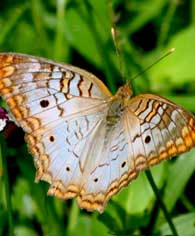
By Laura Willhoft, Naturalist
October 22, 2011 ~ Feather Report
Bird action on the Kiawah River has been spectacular lately. Tree Swallows are here by the thousands, gobbling up tons of gnats and flying insects around the salt marsh. Palm Warblers have also been plentiful by the Mingo Point dock. Other notable birds seen recently on kayaking tours include Wood Storks, Bald Eagles, Belted Kingfishers, Double-crested Cormorants, and Black Skimmers. And who knows– maybe a Roseate Spoonbill will make its way to our marsh this October like it has in past years.
By Will Oakley, Naturalist
October 19, 2011 ~ Obscure Bird Grasshopper (Schistocerca obscura)
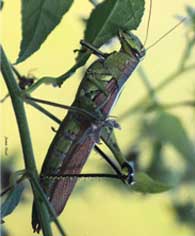
By Will Oakley, Naturalist
October 17, 2011 ~ Feather Report
Bird action on the Kiawah River has been spectacular lately. Tree Swallows are here by the thousands, gobbling up tons of gnats and flying insects around the salt marsh. Palm Warblers have also been plentiful by the Mingo Point dock. Other notable birds seen recently on kayaking tours include Wood Storks, Bald Eagles, Belted Kingfishers, Double-crested Cormorants, and Black Skimmers. And who knows– maybe a Roseate Spoonbill will make its way to our marsh this October like it has in past years.
October 12, 2011 ~ Black Scoter (Melanitta nigra)
Kiawah Town Biologists report Sea ducks have returned to Kiawah Island! Biologists spotted 2 separate groups of black scoters flying over the ocean today. There were a total of approximately 250 ducks between the 2 groups. These are the first scoters we have seen this fall. Numbers of scoters will slowly increase from now until December or January when there will be literally thousands of them in front of the Kiawah beach. Keep an eye out for these fall arrivals if you are out on the beach.
October 9, 2011 ~ Praying Mantis (Mantis religiosa)
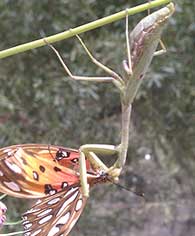 Today, I noticed a beautiful female Carolina Mantis munching on this unfortunate prey item, the Gulf Fritillary (Agraulis vanillae ). The Carolina mantis was found perched on the trunk of a nearby pine tree, but I moved her to my potted flowers to control insects that might harm my flowering cosmos and zinnias. The mantis had been enjoying her new spot camouflaged in with the green flower stems. I had been successful in attracting all sorts of native butterflies to my flowers, and even a few ruby throated hummingbirds! A few seconds after this fritillary had been enjoying his flower nectar, the praying mantis made a quick pouncing motion, guaranteeing him a big afternoon snack. The Carolina mantis is able to turn its head 180 degrees to be able to better catch prey items, their very large compound eyes helping to spot the prey. Moths, flies, grasshoppers and other mantids are common prey items, although butterflies can also fall prey to the very quick reflexes of the mantis. Fun fact: The praying mantis is actually more closely related to cockroaches than to grasshoppers!
Today, I noticed a beautiful female Carolina Mantis munching on this unfortunate prey item, the Gulf Fritillary (Agraulis vanillae ). The Carolina mantis was found perched on the trunk of a nearby pine tree, but I moved her to my potted flowers to control insects that might harm my flowering cosmos and zinnias. The mantis had been enjoying her new spot camouflaged in with the green flower stems. I had been successful in attracting all sorts of native butterflies to my flowers, and even a few ruby throated hummingbirds! A few seconds after this fritillary had been enjoying his flower nectar, the praying mantis made a quick pouncing motion, guaranteeing him a big afternoon snack. The Carolina mantis is able to turn its head 180 degrees to be able to better catch prey items, their very large compound eyes helping to spot the prey. Moths, flies, grasshoppers and other mantids are common prey items, although butterflies can also fall prey to the very quick reflexes of the mantis. Fun fact: The praying mantis is actually more closely related to cockroaches than to grasshoppers!
Photo and observation by Laura Willhoft, Naturalist
October 3 ~ Feather Report ~ Town of Kiawah Bird Banding
Bird banding over the weekend was fantastic! Lots of migrating birds coming through before and after the cold front this weekend just as we expected. We banded 4 days in a row, Friday-Monday. Total birds banded each day: Friday (118), Saturday (96), Sunday (107), and Monday (137). Grand total of 458 birds banded and 11 recaptures in 4 days! Highlights included a Scarlet Tanager on Saturday (first banding record for Kiawah) and a Golden-winged Warbler on Monday (first banding record on Kiawah). We also had quite a few “first of the fall” arrivals, including Indigo Bunting, Orange-crowned Warbler, Gray-cheeked Thrush, Swainson’s Thrush, Eastern Wood-Pewee, Blue-gray Gnatcatcher, Tennessee Warbler, House Wren, and Wood Thrush. Follow the Town’s bird banding research.
By Aaron Given, Town Biologist
October 1, 2011 ~ Northern Puffer (Sphoeroides maculatus)
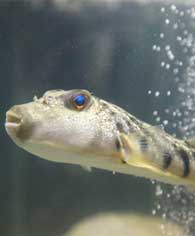 We have an exciting new addition to our saltwater aquarium in the Nature Center! The Northern Pufferfish is a common bottom-dweller found in the Atlantic from Canada to Florida. Our new Pufferfish was found stuck in a baited crab trap along with one of its relatives the Striped Burrfish, who can also be found in our aquarium. The Northern puffer is a unique fish which will inflate itself with either air or water as a last ditch attempt at escape from predation. When the pufferfish is not inflated it is either gracefully swimming around or hiding underneath the sand trying to avoid detection by other predators. This puffer has beautiful blue iridescent eyes which are positioned on the top of its head to help spot prey items from below. Puffers in the wild will typically feed on crustaceans and other invertebrates. While most people think of Pufferfish as highly toxic, the Northern puffer is a species that is not toxic and can be safely eaten. In fish markets, Northern Puffer is sold as “sea squab”! Swing by the Nature Center to check out this cool fish for yourself!
We have an exciting new addition to our saltwater aquarium in the Nature Center! The Northern Pufferfish is a common bottom-dweller found in the Atlantic from Canada to Florida. Our new Pufferfish was found stuck in a baited crab trap along with one of its relatives the Striped Burrfish, who can also be found in our aquarium. The Northern puffer is a unique fish which will inflate itself with either air or water as a last ditch attempt at escape from predation. When the pufferfish is not inflated it is either gracefully swimming around or hiding underneath the sand trying to avoid detection by other predators. This puffer has beautiful blue iridescent eyes which are positioned on the top of its head to help spot prey items from below. Puffers in the wild will typically feed on crustaceans and other invertebrates. While most people think of Pufferfish as highly toxic, the Northern puffer is a species that is not toxic and can be safely eaten. In fish markets, Northern Puffer is sold as “sea squab”! Swing by the Nature Center to check out this cool fish for yourself!
By Laura Willhoft, Naturalist
September 17, 2011 ~ American Mink (Neovison vison)
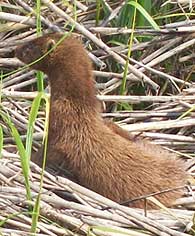 We had just finished “sweeping” the Kiawah River, when Scott Fister noticed a mink walking around on a large mat of dead Spartina grass, right next to the boardwalk, leading down to the dock at Mingo Point. Suddenly, a small cotton rat emerged from the dead grass, where we had last spotted the mink enter through a small opening. The rat paused for a moment, as if it were trying to determine the location of its fierce predator. Finally, the rat quickly scurried away from the area, and we did not see it again. This made complete sense since the cotton rat is a preferred menu item for this very cute, but formidable carnivore. The rat was gone, but the mink continued to hang out next to the boardwalk for at least another hour or so. It really didn’t seem to mind our presence at all. In all, there were about 8 lucky people watching the little guy scratch, clean, and sun himself as we all eagerly watched him- wondering what he might do next. We all had a great morning on the river for the Annual Beach and River sweep. We picked up a lot of trash that morning, only to be rewarded with a rare glimpse of this very elusive creature, the American Mink (Neovison vison).
We had just finished “sweeping” the Kiawah River, when Scott Fister noticed a mink walking around on a large mat of dead Spartina grass, right next to the boardwalk, leading down to the dock at Mingo Point. Suddenly, a small cotton rat emerged from the dead grass, where we had last spotted the mink enter through a small opening. The rat paused for a moment, as if it were trying to determine the location of its fierce predator. Finally, the rat quickly scurried away from the area, and we did not see it again. This made complete sense since the cotton rat is a preferred menu item for this very cute, but formidable carnivore. The rat was gone, but the mink continued to hang out next to the boardwalk for at least another hour or so. It really didn’t seem to mind our presence at all. In all, there were about 8 lucky people watching the little guy scratch, clean, and sun himself as we all eagerly watched him- wondering what he might do next. We all had a great morning on the river for the Annual Beach and River sweep. We picked up a lot of trash that morning, only to be rewarded with a rare glimpse of this very elusive creature, the American Mink (Neovison vison).
Photo and observation by Brad Schmoll, Captain and Naturalist
September 16, 2011 ~ Feather Report
Tour: Back Island Birding
Guide: William Oakley
Locations: Willet Pond, Ocean Course, Osprey Point, The Preserve
Highlights: A Merlin harassing a pair of crows; Black Terns; migrating warblers.
Species: Great Blue Heron, Little Blue Heron, Black-crowned Night Heron, Green Heron, Tricolored Heron, Great Egret, Snowy Egret, Brown Pelican, Laughing Gull, Herring Gull, Royal Tern, Caspian Tern, Sandwich Tern, Black Tern, Common Tern, Black Skimmer, Sanderling, Black-bellied Plover, Clapper Rail, Osprey, Merlin, Northern Mockingbird, Blue Jay, American Crow, Northern Cardinal, Carolina Chickadee, Tufted Titmouse, Carolina Wren, Downy Woodpecker, Red-bellied Woodpecker, Red-eyed Vireo, Prairie Warbler, American Redstart, Yellow Warbler, Palm Warbler, Northern Waterthrush, Ovenbird.
September 15, 2011 ~ Atlantic Bottlenose Dolphin (Tursiops truncatus)

September 15, 2011 ~ Feather Report
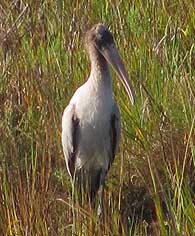 Tour: Back Island Birding
Tour: Back Island Birding
Guide: William Oakley
Locations: Ocean Course, Marsh Island Park, Willet Pond, Osprey Point
Highlights: A Peregrine Falcon attacking a small flock of Least Sandpipers at the Ocean Course beach; Wood Stork at Willet Pond. With only one guest, much of the time was spent tracking down “life birds” for the guest. Life birds spotted today included a Willet, Wood Stork, and Tricolored Heron.
Species: Great Blue Heron, Little Blue Heron, Tricolored Heron, Green Heron, Great Egret, Snowy Egret, Wood Stork, Brown Pelican, Anhinga, Least Sandpiper, Willet, Sanderling, Semi-palmated Plover, Laughing Gull, Herring Gull, Royal Tern, Sandwich Tern, Common Tern, Forster’s Tern, Black Skimmer, Clapper Rail, Osprey, Peregrine Falcon, Turkey Vulture, unknown crow, Mourning Dove, Northern Mockingbird, Red-bellied Woodpecker, Downy Woodpecker, Northern Cardinal, Blue Jay, Carolina Chickadee, Carolina Wren, Boat-tailed Grackle, Red-winged Blackbird
September 11, 2011 ~ Feather Report
Tour: Back Island Birding
Guide: William Oakley
Locations: Ocean Course, Mingo Point, Marsh View Tower, Osprey Point
Highlights: close looks at Yellow Warblers, American Redstart, and Black-crowned Night-Heron
Species: Clapper Rail, Common Gallinule, Great Blue Heron, Little Blue Heron, Black-crowned Night-Heron, Tricolored Heron, Great Egret, Snowy Egret, Anhinga, Brown Pelican, Least Sandpiper, Royal Tern, Laughing Gull, Belted Kingfisher, American Crow, Blue Jay, Boat-tailed Grackle, Downy Woodpecker, Northern Cardinal, Carolina Wren, Carolina Chickadee, Tufted Titmouse, American Redstart, Yellow Warbler, Barn Swallow, Mourning Dove, Northern Mockingbird, Brown Thrasher
September 8, 2011 ~ American alligator (Alligator mississippiensis)

September 7 , 2011 ~ Bald Eagle (Haliaeetus leucocephalus)
While leading a recent Family Kayaking tour on the Kiawah River, Naturalist William Oakley spotted an adult Bald Eagle flying relatively low over the marsh. The fall time is a great time for raptors of all sorts, and what better way to enjoy them than by kayaking right underneath them.
September 5, 2011 ~ Red-eyed Vireo (Vireo olivaceus)
A dead Red-eyed Vireo was discovered in the Kamp Pavilion this past week by Kamp Kiawah staff. “Crime scene” clues suggest the vireo fatally struck a pavilion window and fell on top of a storage box.
Each year, an estimated 900 million birds are killed in window collisions in the United States. Unfortunately, there is no quick and easy fix to this problem. Some fixes are ineffective (falcon silhouette decals), unsightly (hanging CD’s/string), or too costly. But based on homemade experiments, author/birding expert, David Allen Sibley, is hopeful that “easy and inexpensive solutions to this problem exist”.
William Oakley, Naturalists
August 24, 2011 ~ Feather Report
Calm winds made for a much more productive morning for bird banding. We captured 28 new birds and 6 recaptures of 11 species. We had some interesting birds including a Traill’s Flycatcher and a Common Ground-Dove. Ground-doves are fairly common at the banding station but are rarely captured in the nets. We also captured some first-of-the-season warblers: Common Yellowthroat, Yellow Warbler, and Yellow-breasted Chat.
Aaron Given, Kiawah Town Biologist
August 20, 2011 ~ American Mink (Neovison vison)
On my kayaking tour, I was curious when I saw a swimming object in the middle of one of our creeks. Upon further inspection, I determined the animal to be an American Mink! This is the first time I have ever seen this animal in the wild, although they live very close to where we frequently paddle. Mink are small rodent sized carnivorous mammals with a long streamlined body that helps them to swim. On Kiawah, Mink, like River Otters will construct and live in dens that are found on the edges of hammock islands. They spend lots of time swimming in the water to hunt, and can dive to depths of about 16ft!
Laura Willhoft, Naturalist
August 19, 2011 ~ Atlantic Needlefish (Strongylura marina)
On our Tidal Trip & Dip kayak tour, I was shocked to find a small, injured Atlantic Needlefish in my cast net. I caught the fish in the Kiawah River by Captain Sam’s Spit. Its wounds suggested it barely escaped a recent attack by some hungry predator. Bottlenose Dolphins, along with juvenile Lemon Sharks and tarpons, are known to feed on the Atlantic Needlefish.
Drew Heyward, Naturalist
August 17, 2011 ~ Gill Louse (Lironeca ovalis)
 Protandrous, hermaphroditic gill parasite.
Protandrous, hermaphroditic gill parasite.
That’s not a phrase you often hear at work, or on vacation– unless you work or vacation with the Kiawah Island Nature Program. I discovered a recent protandrous, hermaphroditic gill parasite on a female fish during a recent Ocean Seining tour.
Lironeca ovalis, or Gill Louse, is the parasite’s name, and it is a type of crustacean called an isopod. And likely being a protandrous hermaphrodite, the young parasitic male louse will eventually change sex and become a functional female. How amazing is that!
Will Oakley, Naturalist
August 15, 2011 ~ Buff-breasted Sandpiper (Tryngites subruficollis)
Kiawah Town Biologist reported a single buff-breasted sandpiper on the beach near the Ocean Course Clubhouse. This is a rare bird for Kiawah though we have seen buff-breasted sandpipers in this same area for several years in a row, typically during the first few weeks of September. These birds are migrating south from breeding areas and will likely leave our area soon on their way to South America for the winter.
August 13, 2011 ~ White-tailed Deer (Odocoileus virginianus)
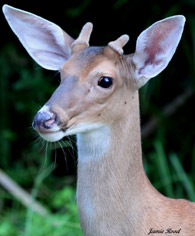 Kiawah deer are in velvet. Growing antlers are tender, this velvet covering carries is a network of blood vessels delivering the nutrients needed for the growing antlers. When alters have grown to full maturity, the velvet dies and falls off.
Kiawah deer are in velvet. Growing antlers are tender, this velvet covering carries is a network of blood vessels delivering the nutrients needed for the growing antlers. When alters have grown to full maturity, the velvet dies and falls off.
This photo of a young buck was taken by Jamie Rood our staff photographer and instructor for our weekly Nature Photography classes.
August 12, 2011 ~ Painted Bunting (Passerina ciris)
Looking for buntings on Kiawah? According to Aaron Given, Kiawah Town Biologist, Painted Buntings become very shy this time of year. Males are getting harder to find because they are not singing and they are preparing for (if not already started) molt. Interestingly, unlike the western population, eastern Painted Bunting molt on the breeding grounds before migration.
August 9, 2011 ~ Bottlenose Dolphin (Tursiops truncatus)
Flabbergasted! That’s the only word I can think of to describe how I felt when two Bottlenose Dolphins came swimming by my guests’ kayaks in a marsh creek at low tide.It’s not unusual to run across Bottlenose Dolphins swimming in the Kiawah River or even in the bigger tidal creeks; but in two feet of water? In a nearly dried-up tidal creek no wider than a school bus? I thought I had seen all Kiawah’s marshes had to offer in three years of leading kayak tours here. I love it when Nature proves me wrong.
Will Oakley, Naturalist
August 7, 2011 ~ Pileated Woodpecker (Dryocopus pileatus)
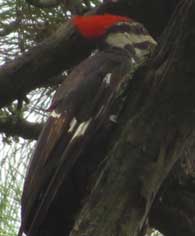 Biking on Eugenia Avenue last week, my ears caught the faint singing of a Painted Bunting in an undeveloped wooded lot. With my camera ready and my eyes scanning the pine trees, I investigated the source of the song, but as I approached closer to the songster, he inched farther away. Fortunately, my short attention span and keen eyes allowed me to pick up on a female Pileated Woodpecker in a nearby pine tree. These birds are stunning in size and color. Their prominent red crests are easy to spot, and their large size makes them distinguishable from other woodpeckers on Kiawah.
Biking on Eugenia Avenue last week, my ears caught the faint singing of a Painted Bunting in an undeveloped wooded lot. With my camera ready and my eyes scanning the pine trees, I investigated the source of the song, but as I approached closer to the songster, he inched farther away. Fortunately, my short attention span and keen eyes allowed me to pick up on a female Pileated Woodpecker in a nearby pine tree. These birds are stunning in size and color. Their prominent red crests are easy to spot, and their large size makes them distinguishable from other woodpeckers on Kiawah.
Will Oakley, Naturalist
August 5, 2011 ~ Feather Report
Tour: Back Island Birding
Guide: William Oakley
Locations: Mingo Point, Willet Pond (front and back), Marsh Island Park
Highlights: Painted Bunting (adult male) singing at Marsh Island Park; a dozen Glossy Ibis flying overhead at the Ocean Course.
Species: Brown Pelican, Royal Tern, Laughing Gull, Double-crested Cormorant, Anhinga, Snowy Egret, Great Egret, Tricolored Heron, Great Blue Heron, Little Blue Heron, Green Heron, Wood Stork, Glossy Ibis, Red-winged Blackbird, Blue Jay, American Crow, Carolina Chickadee, Tufted Titmouse, Carolina Wren, Northern Cardinal, Painted Bunting, Eastern Bluebird, Downy Woodpecker, Osprey, Turkey Vulture
August 4, 2011 ~ Spiny crab-like Orb Weaver (Gasteracantha cancriformis)
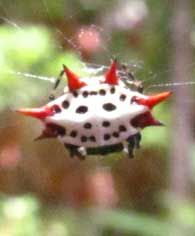 Spend enough time exploring Kiawah’s forest edges and vacant woodland lots, and you’ll definitely run into a spider web or two. If you’re lucky, you’ll come face to face with a female Spiny Crab-like Orb Weaver. This diminutive spider bears 6 abdominal spines and varies in color based on geography. Like in many spider species, female spiny crab-like orb weavers are larger than males, and it is the males who court females prior to mating. To learn more about these fascinating arachnids, check out our Secret Life of Bugs classroom program at the Night Heron Park Nature Center.
Spend enough time exploring Kiawah’s forest edges and vacant woodland lots, and you’ll definitely run into a spider web or two. If you’re lucky, you’ll come face to face with a female Spiny Crab-like Orb Weaver. This diminutive spider bears 6 abdominal spines and varies in color based on geography. Like in many spider species, female spiny crab-like orb weavers are larger than males, and it is the males who court females prior to mating. To learn more about these fascinating arachnids, check out our Secret Life of Bugs classroom program at the Night Heron Park Nature Center.
August 3, 2011 ~ Black Tern (Chlidonias niger)
Kiawah Town Biologists have reported flocks of 30-40 black terns on the west end of the beach near Captain Sam’s Inlet. These early migrating terns are common on Kiawah’s beach during late July and August. They are normally seen roosting/resting on both ends of the island.
August 1, 2011 ~ American Alligator (Alligator mississippiensis)
Town Biologists and KICA Lakes Department staff completed their annual alligator population survey. They saw 157 alligators the first night and 149 the second night. These numbers were averaged and then converted into a population estimate using a formula based on pond water temperature. The estimate for 2011 was 462 alligators. Alligator numbers have remained fairly stable over the last few years. To find out more about alligators and to see all the historic survey data, visit the town’s wildlife website: https://www.kiawahisland.org/wildlife/
July 28, 2011 ~ Loggerhead Sea Turtle (Caretta caretta)
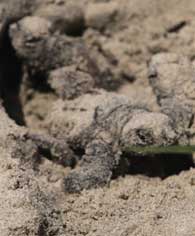
July 27, 2011 ~ Eastern Spadefoot Toad (Scaphiopus holbrookii)
Few sounds compare to that of a steamy day after heavy rains here on Kiawah. One sound that stands out, is the loud bellow of the Eastern Spadefoot Toad (Scaphiopus holbrookii.) These toads spend the majority of their time buried in loose soil waiting to hear the soft taps of rain. When the rain came this week, spadefood toads came out to feed. The eight inches of rain that Kiawah experienced also produced the temporary pools necessary for their mating. This strategy is ideal as temporary puddles rarely have aquatic predators. For those on Kiawah, you may be able to find or spot some of their eggs still in puddles even days after the rains.
If you can’t wait for the next rain you can find their unique chorus hear, http://www.uga.edu/srelherp/anurans/scahol.htm
By Mike Frees, Naturalist/Charter Captain
July 24, 2011 ~ American alligator (Alligator mississippiensis)
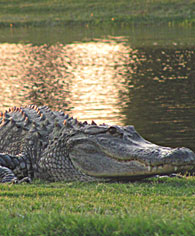 Guest#1: “Where are all the alligators this summer?”
Guest#1: “Where are all the alligators this summer?”
Guest #2: “I saw so many more alligators last year. Where did they all go?”
Naturalist Will Oakley: “I assure you, both. The alligators are still here. And their numbers are strong.”Finding alligators on Kiawah Island during the summer months can be tricky, especially if you know nothing of alligator biology. Fortunately, I’m here to give you a few tips on when and where to look for alligators on Kiawah.
Tip #1: Start early. Gators will bask early in the morning and then move back into the cooler ponds during the hotter parts of the day.
Tip #2: Look later in the day. I’ve seen 14-16 alligators lying out by the Osprey Point clubhouse at 8:00pm. Sunset + gators=awesome photos.
Tip #3: Search for freshwater. Most ponds on Kiawah are brackish water (salt+fresh). Look for more freshwater ponds like those near Osprey Point and Ocean Course clubhouses.
Tip #4: Repeat the above tips until you find the gators. Luck is always involved.
Tip #5: Sign up for an Alligator Adventure or a Gator Walk tour through the Nature Center.
July 22, 2011 ~ Feather Report
Tour: Back Island Birding
Guide: William Oakley
Locations: Mingo Point, Pond #22, Bass Pond, Ibis Pond, Willet Pond, The Enclave at Turtle Point
Highlights: Flushing a Least Bittern on the Ocean Course side of Willet Pond; An adult Yellow-crowned Night Heron at Bass Pond; Wood Storks at Mingo Point, Ibis and Willet Ponds.
Species: Great Blue Heron, Tricolored Heron, Yellow-crowned Night Heron, Black-crowned Night Heron, Green Heron, Great Egret, Snowy Egret, Least Bittern, Common Moorhen, Wood Stork, Laughing Gull, Least Tern, Black Skimmer, Brown Pelican, Anhinga, Turkey Vulture, Osprey, Barn Swallow, Carolina Chickadee, Tufted Titmouse, Carolina Wren, Painted Bunting, Northern Cardinal, Eastern Bluebird, Blue Jay, Fish Crow, American Crow, Red-winged Blackbird, Boat-tailed Grackle, Red-bellied Woodpecker, European Starling, House Finch, Brown Thrasher, Northern Mockingbird.
July 21, 2011 ~ West Indian manatee (Trichechus manatus)
Three more sightings of the manatee in the marsh today between Captain Sam’s and the Kiawah Island bridge.
July 20, 2011 ~ West Indian manatee (Trichechus manatus)
Today at 6:30 pm, the Lurch family spotted a manatee near Captain Sam’s Inlet.
July 20, 2011 ~ American Alligator (Alligator mississippiensis)
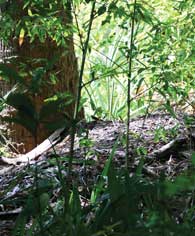 We are anxiously awaiting the start of our alligator hatching season on the island which will take place in mid to late August! Our KICA Lakes Dept. works hard to try to locate nests that have been laid by the mama alligator, in an attempt to monitor the health of our alligator population! The eggs (around 40-60 that are laid) incubate under a huge pile of decomposing grass, sticks, pieces of plants, and mud for about 60 days before the hatchlings emerge. The nests are mound shaped and can be 7 feet across and 3 feet tall. Nests are usually laid in the vicinity of a pond, in a wooded, protected area.
We are anxiously awaiting the start of our alligator hatching season on the island which will take place in mid to late August! Our KICA Lakes Dept. works hard to try to locate nests that have been laid by the mama alligator, in an attempt to monitor the health of our alligator population! The eggs (around 40-60 that are laid) incubate under a huge pile of decomposing grass, sticks, pieces of plants, and mud for about 60 days before the hatchlings emerge. The nests are mound shaped and can be 7 feet across and 3 feet tall. Nests are usually laid in the vicinity of a pond, in a wooded, protected area.
If you do see a nest while on Kiawah, please stay away! It is quite dangerous to be close to the nest, as the mama is always close by and might mistake you for a predator trying to harm her eggs.
We have installed an outdoor camera on our nest at Night Heron Park to view the hatching process, so stay tuned for updates!
July 19, 2011 ~ Feather Report
Guide: William Oakley
Locations: Sea Marsh Egret Roost, Marsh View Tower, Osprey Point, Ocean Course
Highlights: An after second-year male Painted Bunting singing in the open by hole #6 at Cougar Point Golf Course. The bunting was visible from the Marsh View tower. Two Loggerhead Shrikes perched on the fence by the Ocean Course driving range.
Species: Wilson’s Plover, Semipalmated Plover, American Oystercatcher, Least Tern, Great Blue Heron, Black-crowned Night Heron, Green Heron, Great Egret, Snowy Egret, Anhinga, Loggerhead Shrike, Osprey, Turkey Vulture, Barn Swallow, Tufted Titmouse, Carolina Chickadee, Northern Cardinal, Fish Crow, Brown Thrasher, Common Moorhen
July 18, 2011 ~ Painted Bunting (Passerina ciris)
 Painted Buntings are a very sought-after songbird on our Back Island Birding tour, and for good reason: Adult males are drenched in stunning plumage colors like bright red, blue, yellow, and lime green. Here on Kiawah Island, it’s not only the “birders” who are searching for Painted Buntings, though. One of Kiawah’s Town Biologists, Aaron Given, is trapping and banding the Painted Buntings at backyard feeders in order to provide data for his Bird Monitoring Program here on the island. The numbers of Painted Buntings along the east coast have been declining for decades due to habitat loss through human development and agricultural practices, and many scientists and concerned citizens are devoting time and money toward monitoring these very special birds.
Painted Buntings are a very sought-after songbird on our Back Island Birding tour, and for good reason: Adult males are drenched in stunning plumage colors like bright red, blue, yellow, and lime green. Here on Kiawah Island, it’s not only the “birders” who are searching for Painted Buntings, though. One of Kiawah’s Town Biologists, Aaron Given, is trapping and banding the Painted Buntings at backyard feeders in order to provide data for his Bird Monitoring Program here on the island. The numbers of Painted Buntings along the east coast have been declining for decades due to habitat loss through human development and agricultural practices, and many scientists and concerned citizens are devoting time and money toward monitoring these very special birds.
Will Oakley, Naturalist
July 13, 2011 ~ Kaydids
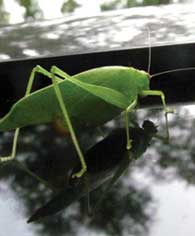 Look closely at your garden (or even at your car window!), and you may find a katydid or two lurking about. Katydids are close cousins of grasshoppers and crickets, spending much of their life in trees and shrubs feeding on leaves, flowers, seeds, and sometimes small insects. Their green, leaf-like appearance helps them blend in with leafy vegetation, and males of most species produce nighttime songs to attract females by rubbing their forewings together.
Look closely at your garden (or even at your car window!), and you may find a katydid or two lurking about. Katydids are close cousins of grasshoppers and crickets, spending much of their life in trees and shrubs feeding on leaves, flowers, seeds, and sometimes small insects. Their green, leaf-like appearance helps them blend in with leafy vegetation, and males of most species produce nighttime songs to attract females by rubbing their forewings together.
July 12, 2011 ~ Kemp’s Ridley (Lepidochelys kempii)
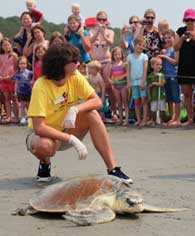 Three turtles, two juvenile loggerheads and one adult female Kemp’s Ridley (which is rare off the SC coast), were rehabilitated by the SC Aquarium’s Sea Turtle Hospital. They’ve received top-notch medical care over the past few months and have all received a clean bill of health. So today they were released back into the Atlantic Ocean at Kiawah’s Beachwalker County Park.
Three turtles, two juvenile loggerheads and one adult female Kemp’s Ridley (which is rare off the SC coast), were rehabilitated by the SC Aquarium’s Sea Turtle Hospital. They’ve received top-notch medical care over the past few months and have all received a clean bill of health. So today they were released back into the Atlantic Ocean at Kiawah’s Beachwalker County Park.
Bennett, an adult female Kemp’s ridley, the most endangered of all the species of sea turtles, was also caught by SCDNR’s research vessel Lady Lisa on June 9, 2011. Bennett was found with a stingray barb wound in her body cavity by the right rear flipper. Treatment included wound flushing, antibiotics, fluids and vitamins. Outside of the stingray injury, she is was in excellent health and made a speedy recovery. Bennett is the first adult female Kemp’s ridley that has ever been admitted into the Sea Turtle hospital.
July 11, 2011 ~ White-tailed Deer (Odocoileus virginianus)
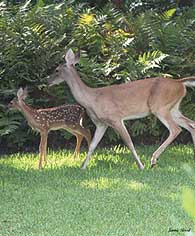 For the last 3 days a fawn has been camping out comfortably on a resident’s front porch here on Kiawah. They witnessed the Doe bring the fawn up and leave it on the porch but became concerned when they had not seen the Doe return for over a day now. I stopped by the house this evening to see the fawn and sure enough there it was hidden in the corner behind a rocking chair. I was waved inside to talk with the owner and see the fawn thru the kitchen window. As we were talking about how the Doe leaves and comes back, suddenly the fawn leapt up and ran out on the lawn only to be greeted by its mom. It went right under her to nurse and then they were interrupted by a barking dog in the distance. Hearing this dog made them go off towards the woods. Only time will tell if the fawn will return to the porch…
For the last 3 days a fawn has been camping out comfortably on a resident’s front porch here on Kiawah. They witnessed the Doe bring the fawn up and leave it on the porch but became concerned when they had not seen the Doe return for over a day now. I stopped by the house this evening to see the fawn and sure enough there it was hidden in the corner behind a rocking chair. I was waved inside to talk with the owner and see the fawn thru the kitchen window. As we were talking about how the Doe leaves and comes back, suddenly the fawn leapt up and ran out on the lawn only to be greeted by its mom. It went right under her to nurse and then they were interrupted by a barking dog in the distance. Hearing this dog made them go off towards the woods. Only time will tell if the fawn will return to the porch…
Jamie Rood, Nature Program, Staff Photographer
July 9, 2011 ~ Osprey (Pandion haliaetus)
In order to continue to monitor the health of our island wildlife, the Kiawah Island Community Association Lakes Department conducts an annual Osprey nest survey. Here is a map of all known active nests for the 2011 season. Any additional nests can be reported to the Heron Park Nature Center at 843.768.6001.
July 8, 2011 ~ Banded Watersnake (Nerodia fasciata)
This beautiful Banded Water Snake was spotted by Jamie Rood on her Nature Photography class. Water snakes are fairly heavy-bodied semi-aquatic animals. Coloration is not a good tool to identify water snakes because it can be highly variable, ranging from light brown or reddish to black with large, darker cross bands. In addition, the crossbands may be obscured as the snake darkens with age, and some individuals appear uniformly dark.
July 7, 2011 ~ Loggerhead Sea Turtle (Caretta caretta)
First sea turtle nest of the season has hatched.
June 29, 2011 ~ Wild Turkey
Town Biologists reported a hen wild turkey was seen today at the end of Ocean Course Drive
June 22, 2011 ~ Loggerhead Sea Turtles (Caretta caretta)
Kiawah’s beach has 135 nests as of June 22nd. That is 21 more nests than we had on June 22nd in 1999, when we had our largest nesting season ever!
Kiawah Island Turtle Patrol has put together a wonderful document comparing nesting rates over the past few years, check it out!
June 21, 2011 ~ Pigmy Sperm Whale (Kogia breviceps)
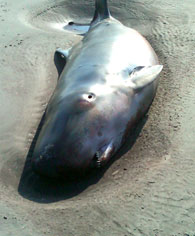 A pygmy sperm whale was found dead on the beach this morning near the Ocean Course. It was an adult male measuring more than 10 feet in length. The whale was necropsied by NOAA/CCEHBR personnel, who reported it to be in “good, robust body condition” and the cause of death remains unknown. Town Biologists report marine mammal strandings are rare events on Kiawah’s beach, averaging 1-3 per year.
A pygmy sperm whale was found dead on the beach this morning near the Ocean Course. It was an adult male measuring more than 10 feet in length. The whale was necropsied by NOAA/CCEHBR personnel, who reported it to be in “good, robust body condition” and the cause of death remains unknown. Town Biologists report marine mammal strandings are rare events on Kiawah’s beach, averaging 1-3 per year.
June 20, 2011 ~ Goose Barnacles (Lepas anatifera)
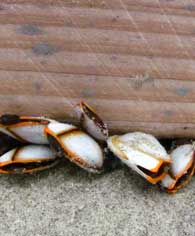 “One person’s garbage is another person’s treasure.”
“One person’s garbage is another person’s treasure.”
Take driftwood, for example. I love examining every nook and cranny of driftwood that washes up on Kiawah’s beach, because the seemingly lifeless piece of wood is a treasure trove of animated passengers picked up at sea. Goose barnacles (see picture) are one type of animal that lives attached to floating objects at sea, and unlike many other barnacles, which filter-feed, the goose barnacle (Lepas anatifera) is reported to feed on small fishes and floating pelagic cnidarians like the Portuguese man-of-war and the Blue Button.
Will Oakley, Naturalist
June 17, 2011 ~ American Alligator (Alligator mississippiensis)
Today, our Naturalists released a young alligator from a crab trap. That was a first!
June 15, 2011 ~ Red Drum (Sciaenops ocellatus)
 Using Blue Crab as bait, this Red Drum (a.k.a. Spottail Bass) was caught in Kiawah’s salt marsh.
Using Blue Crab as bait, this Red Drum (a.k.a. Spottail Bass) was caught in Kiawah’s salt marsh.
June 14, 2011 ~ Feather Report
Guide: William Oakley
Locations: The Preserve, The Ocean Course, Osprey Point, East Beach Tennis Villas, Willet Pond, Marsh Island Park
Highlights: Painted Bunting males singing at Marsh Island Park; Osprey nests with nestlings at Osprey Point and the East Beach Tennis Villas bridge; Green Heron fledglings at Osprey Point
Species: Common Moorhen, Brown Pelican, Laughing Gull, Royal Tern, Least Tern, American Oystercatcher, Black Skimmer, Great Blue Heron, Little Blue Heron, Green Heron, Tricolored Heron, Great Egret, Snowy Egret, Osprey, Black Vulture, Wood Stork, Eastern Kingbird, Great-crested Flycatcher, Northern Parula, Yellow-throated Warbler, House Finch, Eastern Bluebird, Blue Jay, Fish Crow, American Crow, Red-winged Blackbird, Brown-headed Cowbird, Northern Cardinal, Painted Bunting Carolina Wren, Carolina Chickadee, Tufted Titmouse, Downy Woodpecker, Red-bellied Woodpecker, Orchard Oriole, Boat-tailed Grackle, Common Grackle
June 14, 2011 ~ Atlantic Bottlenose Dolphin (Tursiops truncatus)
Field Report by Captain John Ward: New baby dolphin in our pod probably about 3 days old only about 20″ long. Been around our dock and Beachwalker Park all day. Still has its baby camo color and is trying hard to control its buoyancy.
June 13, 2011 ~ Pileated Woodpecker (Dryocopus pileatus)
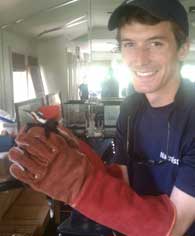 This past Saturday an injured adult male Pileated Woodpecker was brought into the nature center by a concerned family who found it near their home. Nearly the size of a crow, Pileated Woodpeckers are the largest woodpecker in the Eastern United States. Boasting a large and blunt beak, as well as an extremely powerful peck, these birds are able to excavate large rectangular holes in search of food. Using its abnormally long tongue it forages the newly created hole for an array of insects. These woodpeckers are large and unmistakable with a red Mohawk-like tuft on the back of the head and a loud, shrill call. This particular Pileated Woodpecker was rushed by Naturalist Catherine Goodnight to the Birds of Prey Center in Awendaw, SC where it will be treated and hopefully be released back into the wild in the near future.
This past Saturday an injured adult male Pileated Woodpecker was brought into the nature center by a concerned family who found it near their home. Nearly the size of a crow, Pileated Woodpeckers are the largest woodpecker in the Eastern United States. Boasting a large and blunt beak, as well as an extremely powerful peck, these birds are able to excavate large rectangular holes in search of food. Using its abnormally long tongue it forages the newly created hole for an array of insects. These woodpeckers are large and unmistakable with a red Mohawk-like tuft on the back of the head and a loud, shrill call. This particular Pileated Woodpecker was rushed by Naturalist Catherine Goodnight to the Birds of Prey Center in Awendaw, SC where it will be treated and hopefully be released back into the wild in the near future.
Drew Heyword, Naturalist
June 10, 2011 ~ Blue Button Jellyfish (Porpita porpita)
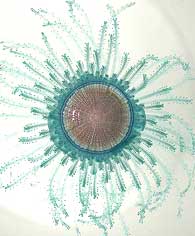 Making its Wildlife: As We See It debut is the small but stunning Blue Button (Porpita porpita). Recently discovered on Kiawah’s beach by an island guest, the aptly named Blue Button appears like a whitish, half-dollar-sized disc with bright blue marginal tentacles radiating outward like daisy petals. The Blue Button is a harmless close relative of the Portuguese Man-O’-War, spending its adult life floating and feeding at the surface of the sea.
Making its Wildlife: As We See It debut is the small but stunning Blue Button (Porpita porpita). Recently discovered on Kiawah’s beach by an island guest, the aptly named Blue Button appears like a whitish, half-dollar-sized disc with bright blue marginal tentacles radiating outward like daisy petals. The Blue Button is a harmless close relative of the Portuguese Man-O’-War, spending its adult life floating and feeding at the surface of the sea.
Interesting Fact: The skin of the Blue Button secretes a water repellent mucus that may aid in flotation.
By Will Oakley, Naturalist
June 7, 2011 ~ Feather Report
Guide: William Oakley
Locations: Courtside Villas (East Beach), The Preserve, Osprey Point Golf Course, Night Heron Park, Mingo Point
Highlights: A breeding pair of adult Osprey is raising two young by the Courtside Villas in East Beach. Our group was lucky enough to witness the male bring in a large fish, which the mother proceeded to tear apart and feed to each of her chicks.
Species: Osprey, Cooper’s Hawk, Turkey Vulture, Eastern Kingbird, Great-crested Flycatcher, Eastern Bluebird, Northern Parula, Carolina Wren, Carolina Chickadee, Tufted Titmouse, Brown-headed Nuthatch, Blue Jay, Fish Crow, Northern Cardinal, Painted Bunting, Mourning Dove, Brown-headed Cowbird, Red-bellied Woodpecker, Downy Woodpecker, Orchard Oriole, Red-winged Blackbird, Boat-tailed Grackle, European Starling, Laughing Gull, Royal Tern, Clapper Rail, Brown Pelican, Anhinga, Great Blue Heron, Tricolored Heron, Black-crowned Night Heron, Green Heron, Great Egret, Snowy Egret
June 5, 2011 ~ Loggerhead Sea Turtle (Caretta caretta)
As of today, Kiawah has 62 Loggerhead Sea Turtle nests. To compare, on June 5, 2010 Kiawah had 54 nests and on June 5, 2009 28 nests. Looks like a strong year!
June 4, 2011 ~ Carolina anole (Anolis carolinensis)
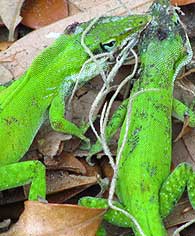 You see them at Night Heron Park. You see them in your backyard. You see them hanging out on the boardwalks by the beach. Their shirts are always off, and they’re usually doing push-ups to impress the ladies. We can not ignore them anymore.
You see them at Night Heron Park. You see them in your backyard. You see them hanging out on the boardwalks by the beach. Their shirts are always off, and they’re usually doing push-ups to impress the ladies. We can not ignore them anymore.
I’m talking, of course, about Green Anoles.
During the Spring and Summer months, these small, green or brown lizards provide ample entertainment for curious island guests. Look carefully for breeding adult anoles (and some juveniles) performing visible courtship displays like head bobbing and “push-ups” or males aggressively defending territories from rival males.
June 3, 2011 ~ Green Sea Turtle (Chelonia mydas)
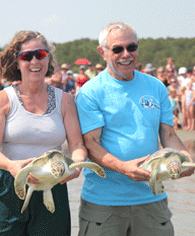 Today, the South Carolina Sea Turtle hospital, located at the SC Aquarium held a Sea Turtle release at Beachwalker County Park! Hundreds of people flocked to wish eight green sea turtles and one 200 pound loggerhead turtle (pictured here) a happy return to the wild. The sea turtles were walked down to the ocean by sea turtle hospital volunteers, as curious onlookers snapped photos and cheered as the turtles swam off towards a second chance at life. The turtles were found throughout the lowcountry and were successfully rehabilitated at the hospital. Many had injuries resulting from the extreme cold temperatures we experienced this past winter. There is no doubt that the natural beauty of the green turtles, or the sheer size of the loggerhead made this a memorable and moving experience for all in attendance.
Today, the South Carolina Sea Turtle hospital, located at the SC Aquarium held a Sea Turtle release at Beachwalker County Park! Hundreds of people flocked to wish eight green sea turtles and one 200 pound loggerhead turtle (pictured here) a happy return to the wild. The sea turtles were walked down to the ocean by sea turtle hospital volunteers, as curious onlookers snapped photos and cheered as the turtles swam off towards a second chance at life. The turtles were found throughout the lowcountry and were successfully rehabilitated at the hospital. Many had injuries resulting from the extreme cold temperatures we experienced this past winter. There is no doubt that the natural beauty of the green turtles, or the sheer size of the loggerhead made this a memorable and moving experience for all in attendance.
Laura Willhoft, Naturalist
June 2, 2011 ~ Green Heron (Butorides virescens)
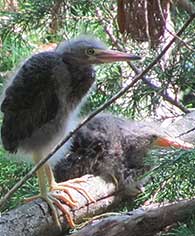 Senior Naturalist William Oakley spotted three Green Heron fledglings hopping around their nest, which the female parent constructed in a cedar tree only a few feet above the popular ‘gator pond by the clubhouse. Judging by their behavior and proximity to the nest, the photographed Green Herons are probably around two weeks old and will completely fledge in an additional 1-2 weeks. Join a Back Island Birding tour for a chance to see these remarkable birds and learn more about their ecology.
Senior Naturalist William Oakley spotted three Green Heron fledglings hopping around their nest, which the female parent constructed in a cedar tree only a few feet above the popular ‘gator pond by the clubhouse. Judging by their behavior and proximity to the nest, the photographed Green Herons are probably around two weeks old and will completely fledge in an additional 1-2 weeks. Join a Back Island Birding tour for a chance to see these remarkable birds and learn more about their ecology.
May 30, 2011 ~ Loggerhead Sea Turtle (Caretta caretta)
As of today, Kiawah has 33 Loggerhead Sea Turtle nests.
May 25, 2011 ~ West Indian manatee (Trichechus manatus)
The first manatee of the season has been spotted in the Kiawah River by Captain John Ward.
May 24, 2011 ~ American Alligator (Alligator mississippiensis)
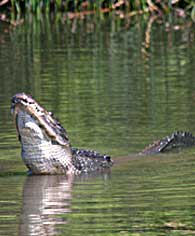 Throughout the month, a male and female alligator have been demonstrating some amazing courtship displays. Hopefully we will have a nest in June.
Throughout the month, a male and female alligator have been demonstrating some amazing courtship displays. Hopefully we will have a nest in June.
May 21, 2011 ~ Feather Report
 Guide: William Oakley
Guide: William Oakley
Locations: Pond 020 (Sea Marsh Drive), Ocean Course, Osprey Point, The Preserve.
Highlights: Heron nestlings are not typically recognized as being “cute”, but the Green Heron nestlings at Pond 020 still had their grey natal down plumage and were oddly cute. They reminded me of bird-like Jim Henson creations. Lots of Least Terns by the Ocean Course driving range. After recent high tides washed over the west-end shorebird breeding grounds near Captain Sam’s Inlet, it appears that the Least Terns are making an
May 17, 2011 ~ Slime mold
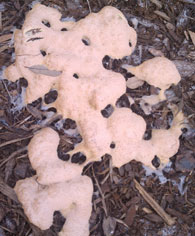 Last Wednesday was the final day of Kiawah Bootcamp, an exercise program that takes place in Night Heron Park. As I was running suicides in the sandy volleyball court and gasping for air, I noticed something I had never seen before growing on the mulch surrounding the volleyball court. It was a yellowish orange color and it looked like it had a foamy texture. As I inspected closer with the other bootcampers, I realized it was one of two things- some sort of fungus, or dog vomit. Later that night, I took it upon myself to do some research. I found out that this fungus-like growth was actually not a fungus at all, but a slime mold! Turns out, slime molds grow in warm, moist environments, and feed on dead organic matter like rotting bark/mulch. They do not harm the environment and are not toxic. This mold is called an ameboid mold as it has no definite shape and the cells form a huge mass (plasmodium) that expands all over looking for food. This species of slime mold has two common names: scrambled egg mold and dog vomit mold!
Last Wednesday was the final day of Kiawah Bootcamp, an exercise program that takes place in Night Heron Park. As I was running suicides in the sandy volleyball court and gasping for air, I noticed something I had never seen before growing on the mulch surrounding the volleyball court. It was a yellowish orange color and it looked like it had a foamy texture. As I inspected closer with the other bootcampers, I realized it was one of two things- some sort of fungus, or dog vomit. Later that night, I took it upon myself to do some research. I found out that this fungus-like growth was actually not a fungus at all, but a slime mold! Turns out, slime molds grow in warm, moist environments, and feed on dead organic matter like rotting bark/mulch. They do not harm the environment and are not toxic. This mold is called an ameboid mold as it has no definite shape and the cells form a huge mass (plasmodium) that expands all over looking for food. This species of slime mold has two common names: scrambled egg mold and dog vomit mold!
By Laura Willhoft
May 14, 2011 ~ Mississippi Kite (Ictinia mississippiensis)
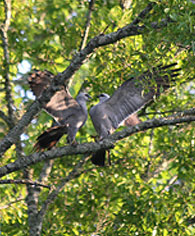
May 12, 2011 ~ American Alligator
Gator mating season is in full swing and love is in the air! We have been lucky to observe lots of mating behavior right from the pond in the back of the Night Heron Pool. There is a female and male that have been showing signs of courtship for the past few weeks, such as bellowing, blowing bubbles, and gentle nuzzling. If you have heard a deep, throaty roar recently near any of the islands many ponds, you might actually be hearing alligator mating calls! Mating season will come to a close at the end of May, and the females will start to lay nests in June. To see some amazing footage of the mating at Night Heron, check out the video on our Nature Program Facebook page!
May 11, 2011 ~ Green Heron (Butorides virescens)
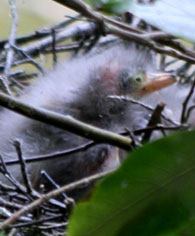
May 10, 2011 ~ Loggerhead Sea Turtles (Caretta Caretta)
Kiawah’s 1st Loggerhead Sea Turtle nest of the season was laid on the beach last night!
May 9, 2011 ~ Pandorus Sphinx Moth (Eumorpha pandorus)
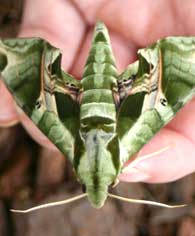
May 5, 2011 ~ White M Hairstreak (Parrhasius m album)
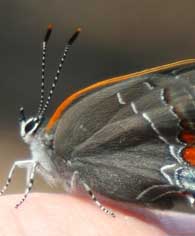
May 4, 2011 ~ Eastern Pondhawk (Erythemis simplicicollis)
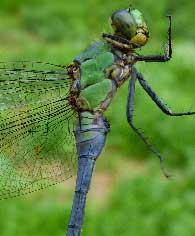 Eastern Pondhawks are a pretty fun species of dragonfly to have around. They are very common, widespread, and adaptable; they have a rockin’ name; they come in two glorious colors, green and blue; and they are pretty tame, easy to approach to photograph or catch in a net. A few hours after this male made the shift from larval dragonfly to adult, he was all green and black, without a hint of blue. Females retain this green color for the rest of their brief life, but males slowly grow a waxy coating of blue, called pruinose. The term is also used for blueberries and grapes, which share a similar waxy coating. This male is halfway through his color change: his abdomen is mostly blue, but his thorax is still mostly green. Even if he were all green we could identify this dragonfly as a male by the little bump at the beginning of his abdomen. Look for a bump at the end of the abdomen to identify a female.
Eastern Pondhawks are a pretty fun species of dragonfly to have around. They are very common, widespread, and adaptable; they have a rockin’ name; they come in two glorious colors, green and blue; and they are pretty tame, easy to approach to photograph or catch in a net. A few hours after this male made the shift from larval dragonfly to adult, he was all green and black, without a hint of blue. Females retain this green color for the rest of their brief life, but males slowly grow a waxy coating of blue, called pruinose. The term is also used for blueberries and grapes, which share a similar waxy coating. This male is halfway through his color change: his abdomen is mostly blue, but his thorax is still mostly green. Even if he were all green we could identify this dragonfly as a male by the little bump at the beginning of his abdomen. Look for a bump at the end of the abdomen to identify a female.
April 30, 2011 ~ Feather Report
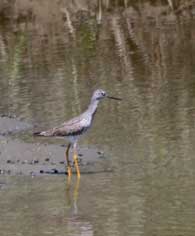 Tour: Carolina Nature Photographer’s Association Field Trip
Tour: Carolina Nature Photographer’s Association Field Trip
Guide: Sarah Ernst
Locations: Willet Island and Pond, Ocean Course Driving Range/Lagoon/Beach/Clubhouse loop
Weather: Clear and sunny, warm but not too hot
Highlights: We started out at Willet Pond and picked up a few songbird and pond species; the definite highlight, though, was seeing at least 20 baby gators at the marsh with mom close by. We then walked the loop and saw a nice variety of beach birds. The highlight for me was getting buzzed by a flock of 6 skimmers, which passed just feet overhead (I could hear their wings!), and spending some time watching the terns; I saw mating or pair-bonding behavior between gull-billed terns, sandwich terns, royal terns, least terns, and laughing gulls. The royal terns are hilarious – we found at least half a dozen males just standing casually on their female’s back; if she moved off, he’d flutter to stay on top. If he slipped off, he’d strut around with his wings curved out and beak held high while she completely ignored him. I found quite a few dog tracks in the dunes where the terns and plovers nest; to help improve on our dismal beach nesting success rate from last year, remember to keep dogs away from beach birds and the nesting areas on either end of the island!
Species: Wood Stork, Double-crested Cormorant, Brown Pelican, Least Bittern, Great Blue Heron, Great Egret, Snowy Egret, Tricolored Heron, Green Heron, Black Vulture, Turkey Vulture, Osprey, Bald Eagle, Clapper Rail, Common Moorhen, Black-bellied Plover, Wilson’s Plover, Semipalmated Plover, American Oystercatcher, Black-necked Stilt, Solitary Sandpiper, Greater Yellowlegs, Willet, Sanderling, Dunlin, Laughing Gull, Ring-billed Gull, Least Tern, Gull-billed Tern, Forster’s Tern, Royal Tern, Sandwich Tern, Black Skimmer, Mourning Dove, Common Ground-Dove, Red-bellied Woodpecker, Great Crested Flycatcher, White-eyed Vireo, Blue Jay, American Crow, Barn Swallow, Carolina Chickadee, Carolina Wren, Eastern Bluebird, Northern Mockingbird, Brown Thrasher, European Starling, Yellow-throated Warbler, Northern Cardinal, Painted Bunting, Red-winged Blackbird, Boat-tailed Grackle
April 29, 2011 ~ Feather Report
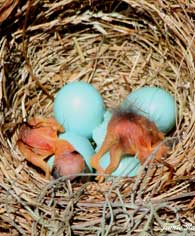
Guide: Sarah Ernst
Locations: Marsh Island Park, Willet Pond and Marsh
Weather: Very pleasant – 70s, clear, not nearly as humid, nice breeze
Highlights: We went to Marsh Island Park right away for buntings but, while we did spot a colorful male, none out in the open long enough to photograph. As a consolation prize, though, our green first-summer male at that spot did give us a nice show. We stopped at the Willet Pond Osprey nest and also found quite a few orchard orioles, two of which decided to mate right in front of us! We then circled around to the other side to get better light on the pond birds. We got some nice close up shots of black-necked stilts and spotted a least bittern and sora in the marsh grass. (What’s up with me and soras lately?!) The most exciting action of the day occurred when three adult eagles appeared over the ocean course, two of which were chasing the third. Eventually one (seemed large, maybe a female) flew over the pond, spooking all the teal, which continued to circle around the pond until the eagle left. This let us get a few nice shots of teal in flight, with their gorgeous blue wing patches!
Species: Blue-winged Teal, Wood Stork, Double-crested Cormorant, Brown Pelican, Least Bittern, Great Blue Heron, Great Egret, Snowy Egret, Tricolored Heron, Turkey Vulture, Osprey, Bald Eagle, Red-tailed Hawk, Sora, Common Moorhen, Black-necked Stilt, Greater Yellowlegs, Laughing Gull, Least Tern, Gull-billed Tern, Forster’s Tern, Mourning Dove, Red-bellied Woodpecker, Great Crested Flycatcher, Eastern Kingbird, Blue Jay, American Crow, Fish Crow, Tree Swallow, Carolina Chickadee, Tufted Titmouse, Brown-headed Nuthatch, Carolina Wren, Blue-gray Gnatcatcher, Eastern Bluebird, Northern Mockingbird, Yellow-throated Warbler, Pine Warbler, Summer Tanager, Northern Cardinal, Painted Bunting, Red-winged Blackbird, Boat-tailed Grackle, Orchard Oriole, House Finch
April 28, 2011 ~ Eastern Gray Squirrel (Sciurus carolinensis)
One of the most unusual things we saw on our Butterflies Walk was a squirrel hanging from her hind legs on a bottlebrush tree, holding a bottlebrush flower with her front paws and lapping up the nectar. Bottlebrush (Callistemon sp.) produces dozens of nectar-rich red flowers in the spring and are particularly attractive to hummingbirds, though we also saw a wasp-mimic fly and a hairstreak butterfly nectaring there as well. Apparently the nectar was rich enough for the squirrel to consider it worth her time, though she paid for it: when she reached for another bloom, she lost her balance and fell out of the tree! But within two minutes she was back up and enjoying the sweet nectar again.
April 27, 2011 ~ Flutter Report
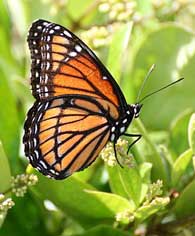
We have dozens of butterfly species on Kiawah, and many of them are active in spring. Here are the butterflies I have noticed this month: Black Swallowtail, Giant Swallowtail, Eastern Tiger Swallowtail, Spicebush Swallowtail, Palamedes Swallowtail, Cloudless Sulphur, Sleepy Orange, Gray Hairstreak, Henry’s Elfin, Variegated Fritillary, Question Mark, American Lady, Red Admiral, Common Buckeye, Phaon Crescent, Viceroy, Carolina Satyr, Monarch, Queen, Silver-Spotted Skipper, Checkered Skipper, and Whirlabout! Of special interest in that group is the Queen – I saw one nectaring on an American Holly at Marsh Island Park. And the Henry’s Elfin was not on our butterfly checklist – of course it has been here all along, but it’s a secretive butterfly that must be sought out in early spring, the only time of year when it can be found as an adult.
April 27, 2011 ~ White-marked Tussock Moth Caterpillar (Orgyia leucostigma)
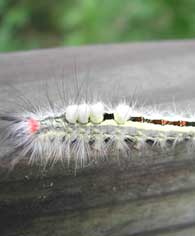 Visit Night Heron Park and it is hard to miss the white-marked tussock moth caterpillar. Interesting fact: the adult female moth is wingless and all she does is emit pheromones for the male to find her. She then lays eggs all over herself…pretty cool!
Visit Night Heron Park and it is hard to miss the white-marked tussock moth caterpillar. Interesting fact: the adult female moth is wingless and all she does is emit pheromones for the male to find her. She then lays eggs all over herself…pretty cool!
April 26, 2011 ~ Feather Report
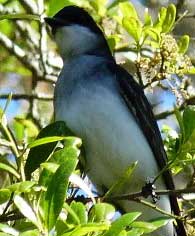
Guide: Sarah Ernst
Locations: Marsh Island Park, Willet Pond and Marsh
Weather: mid 70s, partly cloudy to cloudy, very humid, thunderstorm at the end!
Highlights: We found at least 4, maybe up to 6, painted buntings at Marsh Island Park, both male and female, and including a singing first-summer male who had just a hint of red. We also got a surprise wood stork overhead – this species gets a bit more scarce in spring as they focus on laying eggs and raising chicks in Dungannon and other nesting sites. Other than the buntings, one of the most interesting sights we got was a very calm brown-headed nuthatch, perched on a bare branch and preening. We often spot (or at least hear) the high-canopy, active little nuthatches on birding trips but I think this might be the first time I’ve ever been able to put the spotting scope on it and share a great look. We then went on to Willet Pond, but before we could cover very much ground, lightning and thunder sent us scurrying back to the van. But we still managed to enjoy a great look at a green heron and around a dozen 6 month to 2 year old gators.
Species: Wood Stork, Brown Pelican, Great Blue Heron, Great Egret, Snowy Egret, Tricolored Heron, Osprey, Common Moorhen, Laughing Gull, Least Tern, Royal Tern, Mourning Dove, Red-bellied Woodpecker, Great Crested Flycatcher, Eastern Kingbird, American Crow, Fish Crow, Carolina Chickadee, Brown-headed Nuthatch, Carolina Wren, Blue-gray Gnatcatcher, Northern Cardinal, Painted Bunting, Red-winged Blackbird, Orchard Oriole, House Finch
April 24, 2011 ~ Feather Report
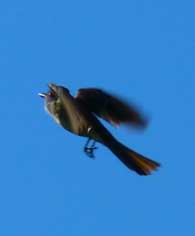
Guide: Sarah Ernst
Locations: Ibis Pond, Willet Island, Willet Pond (and marsh), Ocean Course driving range/lagoon/beach loop, a quick swing by Turtle Pond
Weather: 70s-80s, clear and sunny, very humid, a light breeze at the ocean course but otherwise calm
Highlights: I’m pleased to report that this quiet Easter Sunday morning gave us an awesome assortment of highlights! Osprey all over the place, at all locations. Ibis Pond was full of egrets, laughing gulls, and a few other species. We also heard a few least bitterns but didn’t manage to catch one out of the grass. But as we drove to Willet Pond, I spied a pair of clapper rails bathing in a little tidal salt marsh area. They were completely out in the open and gave us a good five minutes of observation from the van. After bathing they preened, and they seemed to be fanning out their wings in some sort of courtship/pair bonding display. At Willet Island, though, the rails were topped by a sora just strolling around in the mud! That was the easiest sora I’ve ever found. The blue-winged teal have dwindled to just two male-female pairs, but the sunlight was perfect and we got a great look at the beautiful males. We finished Willet Island with a trio of orchard orioles, all in female/young male plumage, but 2/3 singing.
We picked up a second sora in the marsh again, and on the way out to the ocean course found a shrike and a kingbird. At the ocean course lagoon/beach loop, we found shorebirds and terns galore; the highlights of which were dozens of sandwich terns, royal terns, and least terns, all exhibiting some courtship behavior (the spotting scope even caught a pair of least terns mating!). Shorebirds included many of our usual suspects including over 200 dunlin – only one red knot, most have left – lots of Wilson’s plovers, and the special highlight: a trio of whimbrel. By the time we returned to the Ocean Course we were extremely hot and thirsty, but thoroughly satisfied with our morning of birding. 56 species total, excellent for late April!
Species: Blue-winged Teal, Double-crested Cormorant, Brown Pelican, Least Bittern, Great Blue Heron, Great Egret, Snowy Egret, Tricolored Heron, Green Heron, Osprey, Clapper Rail, Sora, Common Moorhen, Black-bellied Plover, Wilson’s Plover, Semipalmated Plover, American Oystercatcher, Black-necked Stilt, Greater Yellowlegs, Willet (Eastern), Lesser Yellowlegs, Whimbrel, Ruddy Turnstone, Red Knot, Sanderling, Western Sandpiper, Least Sandpiper, Dunlin, Short-billed Dowitcher, Laughing Gull, Least Tern, Forster’s Tern, Royal Tern, Sandwich Tern, Black Skimmer, Mourning Dove, Great Crested Flycatcher, Eastern Kingbird, Loggerhead Shrike, American Crow, Fish Crow, Barn Swallow, Carolina Chickadee, Brown-headed Nuthatch, Carolina Wren, Eastern Bluebird, Northern Mockingbird, Brown Thrasher, Northern Parula, Yellow-throated Warbler, Northern Cardinal, Painted Bunting, Red-winged Blackbird, Boat-tailed Grackle, Orchard Oriole, House Finch
April 21, 2011 ~ Feather Report
Kiawah’s beach nesting birds are starting to nest along the beachfront. Today, Town Biologists posted signs around our 2 nesting areas, one on the west end of the island near Captain Sam’s inlet and the other on the east end adjacent to the Ocean Course Driving Range. Please do not enter the area behind these signs for any reason and give these birds a chance to successfully raise their young.
April 20, 2011 ~ Tufted Titmouse (Baeolophus bicolor)
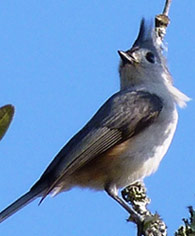 I found this tufted titmouse discreetly flitting out of a small hole in a live oak tree; here, he or she is quietly observing the surrounding territory for predators, competitors, or perhaps a passing beetle or spider to snack on. Chickadees and titmice nest in pre-existing holes, often made by woodpeckers.
I found this tufted titmouse discreetly flitting out of a small hole in a live oak tree; here, he or she is quietly observing the surrounding territory for predators, competitors, or perhaps a passing beetle or spider to snack on. Chickadees and titmice nest in pre-existing holes, often made by woodpeckers.
Naturalist, Sarah Ernst
April 19, 2011 ~ Feather Report
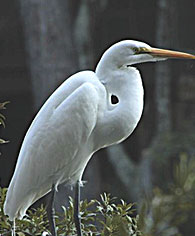 Tour: Back Island Birding
Tour: Back Island Birding
Guide: Sarah Ernst
Locations: Night Heron Park, Marsh Island Park, Killdeer Pond, Willet Pond
Weather: 70s, clear, fairly calm
Highlights: We started out in the hustle and bustle of Night Heron Park, which was filled not only with the music of Kamp Kiawah, but the sound of yellow-throated warblers, nothern parulas, carolina wrens, bluebirds, cardinals, titmice, red-bellied woodpeckers, and a pine warbler. We all got an excellent look at the delicate little yellow-throated warbler on the edge of a clump of spanish moss. At Marsh Island Park, we stalked a few a painted buntings and were rewarded by a good ten minutes of both feeding and singing behaviors, so close up we barely needed our binoculars! In all I counted 3 males on the island, and a female, and another male just off the bridge. Another highlight was a male pileated woodpecker in the woods past the bridge. Killdeer Pond was a total bust, so we went on and paused to watch the osprey rearrange sticks at the Willet Pond nest and continued on to check out the pond…filled with lots of activity, including my first least bittern of the year. At the end of the morning, though, we had the some fascinating bird activity: an enterprising mockingbird had learned that many of the cars had picked up a load of inchworms on their way into the ocean course. It jumped on top of each car as it arrived – sometimes before the owner even turned off the motor! From there, it picked a nice buffet of caterpillars off the top before hopping back to catch a moth in the parking lot, or perch on a tree branch to observe the road for more oncoming cars – and meals. I was taken aback by the cleverness of this bird!
Species: Blue-winged Teal, Pied-billed Grebe, Double-crested Cormorant, Brown Pelican, Least Bittern, Great Blue Heron, Great Egret, Snowy Egret, Green Heron, Osprey, Clapper Rail, Common Moorhen, Black-necked Stilt, Laughing Gull, Least Tern, Mourning Dove, Red-bellied Woodpecker, Pileated Woodpecker, Great Crested Flycatcher, Blue Jay, American Crow, Carolina Chickadee, Tufted Titmouse, Brown-headed Nuthatch, Carolina Wren, Blue-gray Gnatcatcher, Eastern Bluebird, Northern Mockingbird, European Starling, Northern Parula, Yellow-rumped Warbler, Yellow-throated Warbler, Pine Warbler, Northern Cardinal, Painted Bunting, Red-winged Blackbird, Common Grackle, Boat-tailed Grackle, House Finch
April 17, 2011 ~ Geometer Caterpillars
A walk or bike ride on Kiawah these days may get you up close and personal with MANY small, slender green or brown inchworms! You might notice them hanging from the live oak trees or crawling around everywhere on the golf course grass. These inchworms are the caterpillar (or larval stage) of a large group of moths called Geometer moths. The word ‘geometer’ comes from the Latin and means “earth measurer” which refers to the inchworm- like type of locomotion they use. Once they anchor their front legs, they swing the back legs up to meet the front, and the process repeats. This makes the caterpillar look like it is carefully measuring its progress. These caterpillars time their emergence with the spring temperatures, but also with the new growth of the live oak trees!
Fun Fact: When Geometer moths are resting on a surface they will hold out all four of their wings. Most all other moths you are likely to see at nighttime will one hold out two of their wings, you will not see the hind wings!
April 15, 2011 ~ Feather Report
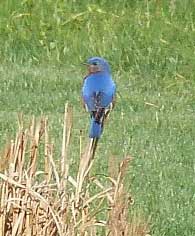 Tour: Back Island Birding
Tour: Back Island Birding
Guide: Sarah Ernst
Locations: Marsh Island Park, Osprey Point, Willet Pond, Ocean Course lagoon/beach
Weather: Really lovely – partly cloudy, high 60s-low 70s, windy at the ocean course
Highlights: We had an interesting day of birding – actually quite a high number of species for one morning of mid-April birding (57), but only a few really good looks at birds. Still, the looks we did get were pretty cool. At Marsh Island Park we heard a painted bunting singing very close, but it was in someone’s yard and we couldn’t trespass and get close enough to see it. We did get much better looks at blue-gray gnatcatchers, a flyby from a pair of pileated woodpeckers, and a blue jay doing a very skillful imitation of a Cooper’s hawk. At Osprey Point we saw my first eastern kingbird of the year, sitting out on a branch and giving us a great look through the spotting scope – I even saw the flash of red on its head! We got a great green heron look at the Ocean Course…the marsh birds at Willet were distant but active and included stilts, egrets, herons, yellowlegs, and around 30 blue-winged teal. The Ocean Course beach was also quiet (low tide) but we got great looks at a pair of oystercatchers, and towards the end of our long trek back to the clubhouse, we found a small flock of shorebirds that included good comparative looks at sanderlings, dunlin, least sandpipers, and a single piping plover. The piping plover was in full breeding plumage, which put it among the cutest things on the planet today!
Species: Blue-winged Teal, Pied-billed Grebe, Double-crested Cormorant, Brown Pelican, Great Blue Heron, Great Egret, Snowy Egret, Tricolored Heron, Green Heron, Black Vulture, Turkey Vulture, Osprey, Common Moorhen, American Coot, Black-bellied Plover, Piping Plover, American Oystercatcher, Black-necked Stilt, Greater Yellowlegs, Willet, Ruddy Turnstone, Sanderling, Least Sandpiper, Dunlin, Laughing Gull, Ring-billed Gull, Herring Gull, Royal Tern, Mourning Dove, Red-bellied Woodpecker, Downy Woodpecker, Pileated Woodpecker, Great Crested Flycatcher, Eastern Kingbird, Blue Jay, American Crow, Fish Crow, Tree Swallow, Barn Swallow, Carolina Chickadee, Tufted Titmouse, Brown-headed Nuthatch, Carolina Wren, Blue-gray Gnatcatcher, Eastern Bluebird, Northern Mockingbird, Brown Thrasher, European Starling, Northern Parula, Yellow-throated Warbler, Pine Warbler, Northern Cardinal, Painted Bunting, Red-winged Blackbird, Common Grackle, Boat-tailed Grackle, House Finch
April 13, 2011 ~ Painted Bunting (Passerina ciris)
Our Naturalist, Sarah Ernst and Town Biologist, Aaron Given both saw their first of the season Painted Bunting today. Sarah saw hers singing from a live oak at Mingo Point and Aaron found his at Captain Sam’s Spit. Interestingly, this is one day earlier than Sarah’s 2010 FOS.
April 12, 2011 ~ Feather Report
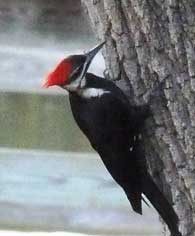 Tour: Audubon International’s Birdwatching Open
Tour: Audubon International’s Birdwatching Open
Location: Cougar Point
Weather: Started humid and partly cloudy, high to mid 60s, got cloudier and eventually started raining a little by the end of the day
Highlights: The highlight today was a very tame female pileated woodpecker who moved from tree trunk to tree trunk, giving us some great looks and photo ops. Green herons and bluebirds in abundance. We saw a male yellow-rumped warbler who had nearly completely molted into breeding plumage. Another highlight was watching the male osprey bring some sticks and spanish moss to the nest; the female appeared to be incubating the whole time. There are still a few winter birds – cedar waxwings, sparrows, ruby-crowned kinglets – as well as some new arrivals like summer tanagers and great crested flycatchers. Other critters of note: Red Admiral and Palamedes Swallowtail butterflies, a few deer, a great antlion spot, and of course gators.
Species List: Double-crested Cormorant, Anhinga, Brown Pelican, Great Blue Heron, Great Egret (American), Snowy Egret, Green Heron, Black-crowned Night-Heron, Turkey Vulture, Osprey, Red-tailed Hawk, Laughing Gull, Mourning Dove, Belted Kingfisher, Red-bellied Woodpecker, Downy Woodpecker, Pileated Woodpecker, Great Crested Flycatcher, Unknown Swallow sp., Blue Jay, American Crow, Fish Crow, Carolina Chickadee, Tufted Titmouse, Brown-headed Nuthatch, Carolina Wren, Blue-gray Gnatcatcher, Ruby-crowned Kinglet, Eastern Bluebird, European Starling, Cedar Waxwing, Northern Parula, Yellow-rumped Warbler, Yellow-throated Warbler, Pine Warbler, Palm Warbler, Song Sparrow, White-throated Sparrow, Summer Tanager, Northern Cardinal, Red-winged Blackbird, Common Grackle, Brown-headed Cowbird, House Finch
April 11, 2011 ~ Grey Sea Star (Luidia clathrata)
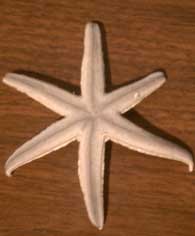 Today, I was excited to have a guest bring me a gray sea star with not 5, not 4, but 6 arms radiating from its central disk! Gray sea stars are the most common species of sea star in our area and typically only have only 5 arms. Earlier this year I was shocked to see my first 4-armed sea star (look back at the entry on January 16th 2011) however, this 6 armed star is just as rare a find. Like in the case of the 4 armed sea star, random mutations are possible which can impact arm development and growth. Also, since sea stars can regenerate arms if they are damaged, it is possible that an arm could split into two while regrowing. These are the two main explanations that might cause any number of arms other than 5. This splitting during regeneration is my guess as to what caused the 6 arms on this particular star!
Today, I was excited to have a guest bring me a gray sea star with not 5, not 4, but 6 arms radiating from its central disk! Gray sea stars are the most common species of sea star in our area and typically only have only 5 arms. Earlier this year I was shocked to see my first 4-armed sea star (look back at the entry on January 16th 2011) however, this 6 armed star is just as rare a find. Like in the case of the 4 armed sea star, random mutations are possible which can impact arm development and growth. Also, since sea stars can regenerate arms if they are damaged, it is possible that an arm could split into two while regrowing. These are the two main explanations that might cause any number of arms other than 5. This splitting during regeneration is my guess as to what caused the 6 arms on this particular star!
By Laura Willhoft, Naturalist
April 6, 2011 ~ Red-shouldered Hawk (Buteo lineatus)
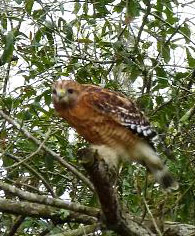 This red-shouldered hawk flew in front of my car this morning and landed in a nearby tree. I was only going 25 mph so I managed to avoid hitting it. Hawks and owls are prone to car strikes because they can tune out the rest of the world – a condition I can certainly relate to! – as they focus hard in their hunt for prey. I managed to get out of my car, pull the camera out of the back, and take a single photo before it flew off. As you can see, “red-shouldered hawk” is another one of those confusing bird names – the shoulders are not the most obviously red part of a red-shouldered hawk.
This red-shouldered hawk flew in front of my car this morning and landed in a nearby tree. I was only going 25 mph so I managed to avoid hitting it. Hawks and owls are prone to car strikes because they can tune out the rest of the world – a condition I can certainly relate to! – as they focus hard in their hunt for prey. I managed to get out of my car, pull the camera out of the back, and take a single photo before it flew off. As you can see, “red-shouldered hawk” is another one of those confusing bird names – the shoulders are not the most obviously red part of a red-shouldered hawk.
By Sarah Ernst, Naturalist
April 5, 2011 ~ Feather Report
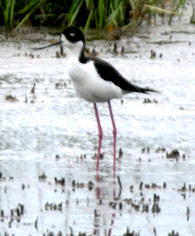
Guide: Sarah Ernst
Locations: Willet Pond, The Ocean Course driving range/lagoon, Sea Marsh Drive
Weather: 60s to begin with but descended to a brisk 50s, windy but clear
Highlights: Thunder and lightning kept us in bed this morning but I scheduled a special evening edition of Back Island Birding. I decided to target shorebirds rather than songbirds or pond birds, and it was SO worth it – the light at the Ocean Course was amazing! Usually by the time I get to the Ocean Course, the sun is high and the birds are washed out. Today we saw the shorebirds in all their sunlit glory. Even the yellow feet of the snowy egret seemed to be glowing gold. Made me wish I had discovered a little earlier how amazing sunset shorebird watching could be. While we saw the stilts at Willet Pond, the grass obscured them from a good view. But as we were watching the dowitchers and dunlin, a pair of stilts flew right up to the mudbank across from us and gave us a really amazing, sunset-lit look at this funky, beautiful bird! We returned to Sea Marsh Drive in time for sunset but there were no birds at all…after spending twenty minutes waiting, we were finally rewarded with some green herons, a black-crowned night heron, and just four great egrets.
Species: Blue-winged Teal, Pied-billed Grebe, Double-crested Cormorant, Brown Pelican, Great Blue Heron, Great Egret, Snowy Egret, Little Blue Heron, Tricolored Heron, Green Heron, Black-crowned Night Heron, Black Vulture, Turkey Vulture, Osprey, Common Moorhen, American Coot, Semipalmated Plover, Black-necked Stilt, Greater Yellowlegs, Willet, Dunlin, Short-billed Dowitcher, Laughing Gull, Ring-billed Gull, Forster’s Tern, Royal Tern, Mourning Dove, American Crow, Fish Crow, Carolina Wren, Northern Mockingbird, Northern Cardinal, Red-winged Blackbird, Common Grackle, Boat-tailed Grackle, House Finch
March 28, 2011 ~ Blue-winged Teal (Anas discors)
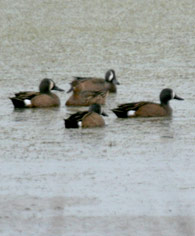 Special thanks to Mr. Branner for reporting a large flock of Blue-winged Teal on Ibis Pond today. Town Biologists added …….”the males are all in bright breeding plumage, so if you are in the area take advantage of this viewing opportunity. It is relatively rare to see this many teal on the island at one time.
Special thanks to Mr. Branner for reporting a large flock of Blue-winged Teal on Ibis Pond today. Town Biologists added …….”the males are all in bright breeding plumage, so if you are in the area take advantage of this viewing opportunity. It is relatively rare to see this many teal on the island at one time.
By Laura Willhoft, Naturalist
March 27, 2011 ~ Luna Moth (Actias luna)
You can consider yourself lucky if you happen upon one of these beautiful pale green Luna Moths. This particular moth was found on neighboring Wadmalaw Island by our Nature Photographer Jamie Rood. We can tell that this moth is a male because of its large bushy antennae; the female Luna Moth has a much slimmer pair of antennae. You are most likely to spot a male of this species since the female does not move around frequently. Instead, she sits and emits pheromones, waiting for the male detect them and approach her for mating. Luna Moths amazingly do not have a mouth in the adult stage, so their sole purpose in life is to mate, and for the female to then lay eggs. To see and read about the Luna moth in its caterpillar (or larval) stage, look back at our November 28th 2010 entry!
By Laura Willhoft, Naturalist
March 26, 2011 ~ Feather Report
Tour: Charleston Audubon Field Trip
Guide: Sarah Ernst
Locations: The fields between Freshfields and Cassique, Ibis Pond, Willet Pond, Ocean Course driving range/lagoon/beach
Weather: 60s-70s, partly cloudy in the morning
Highlights: After meeting at the Heron Park Nature Center and hearing a few summer warblers singing in the park, we drove out to the tomato fields and explored it on foot to find some grassland and thicket species – meadowlarks, savannah sparrows, and a great look at a flock of turkeys were the highlight. We also found purple martins and a cattle egret, first of the season for many of us. Then we headed out to Ibis Pond where we searched the coots, moorhens, and grebes for ducks but no luck…but at Willet Pond there were a trio of nice black-necked stilts. Along the driving range we found a pair of common ground doves and a loggerhead shrike, among the less welcome starlings and house finches. Once we made it to the beach, highlights included the a few flocks of red knots which, conservatively, totaled to at least 1000; a good abundance of Wilson’s plovers here for the breeding season; Bonaparte’s gulls feeding in the ocean; a pair of marbled godwits; a gannet in the distant surf; and a very friendly but slightly ragged looking osprey. We thoroughly enjoyed seeing a mating flight of royal terns; with their angular bodies and perfect fobrrmation flying and tricks, they reminded us of the Blue Angels! Lots of variety of shorebirds as usual; if you don’t mind the hike through the sand, our lagoon/beach area is the perfect living classroom to practice shorebird identification skills. 74 total species today! Some of the birds listed below, like the white-eyed vireo and downy woodpecker, were heard-only.
Species: Bufflehead, Hooded Merganser, Wild Turkey, Pied-billed Grebe, Northern Gannet, Double-crested Cormorant, Anhinga, Brown Pelican, Great Blue Heron, Great Egret, Snowy Egret, Little Blue Heron, Tricolored Heron, Cattle Egret, Turkey Vulture, Osprey, Bald Eagle, Red-tailed Hawk, Common Moorhen, American Coot, Black-bellied Plover, Wilson’s Plover, Semipalmated Plover, Killdeer, American Oystercatcher, Black-necked Stilt, Greater Yellowlegs, Willet, Lesser Yellowlegs, Marbled Godwit, Ruddy Turnstone, Red Knot, Sanderling, Western Sandpiper, Least Sandpiper, Dunlin, Short-billed Dowitcher, Bonaparte’s Gull, Laughing Gull, Ring-billed Gull, Forster’s Tern, Royal Tern, Sandwich Tern, Mourning Dove, Common Ground-Dove, Belted Kingfisher, Red-bellied Woodpecker, Yellow-bellied Sapsucker, Downy Woodpecker, Pileated Woodpecker, Loggerhead Shrike, White-eyed Vireo, Blue Jay, American Crow, Fish Crow, Purple Martin, Eastern Bluebird, Gray Catbird, Northern Mockingbird, Brown Thrasher, European Starling, Northern Parula, Yellow-rumped Warbler (Myrtle), Yellow-throated Warbler, Pine Warbler, Eastern Towhee, Chipping Sparrow, Savannah Sparrow (Eastern), Northern Cardinal, Red-winged Blackbird, Eastern Meadowlark, Common Grackle, Boat-tailed Grackle, House Finch
March 24, 2011 ~ Summer Tanager (Piranga rubra)
I heard my first summer tanager of the spring singing this morning! To my ears the tanager seems to say “chick-bukka-burree!” in a perky tone. “Pik-i-tuk-i-tuk” is another interpretation. Males sing as well; they sound much like a robin, but robins are just a fall-spring bird for us and don’t breed on the island.
Every feather on a male summer tanager is red or reddish, so they might only mistaken for their fellow cardinal family member…the cardinal. But northern cardinals have a distinct crest, black mask and stronger, more triangle-shaped beak. Cardinals are also usually found lower in the trees and bushes, while tanagers prefer the tops of trees. Scarlet tanagers, an occasional migratory bird for us but common though most of the east, also are bright red but have black wings.
Naturalist, Sarah Ernst
March 23, 2011 ~ Dovekie (Alle alle)
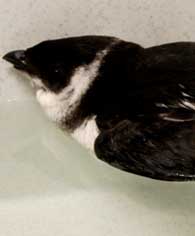 Property owner Charles Marti found an extremely rare bird on Kiawah’s beach – a dovekie. This dapper, pint-sized bird is a member of the Auk family – the Arctic’s version of the Southern Hemisphere’s penguins. Dovekies usually winter as far south as New England, and occasionally to Virginia. But this year we had several spotted in the Carolinas. This dovekie was the first ever recorded on Kiawah Island. Sadly, the bird died before it could be taken to rehab. Emaciation, a lice infestation, and a torn-up foot probably contributed to the dovekie’s stranding and death; our recent strong winds and surf probably pushed it to our beach.
Property owner Charles Marti found an extremely rare bird on Kiawah’s beach – a dovekie. This dapper, pint-sized bird is a member of the Auk family – the Arctic’s version of the Southern Hemisphere’s penguins. Dovekies usually winter as far south as New England, and occasionally to Virginia. But this year we had several spotted in the Carolinas. This dovekie was the first ever recorded on Kiawah Island. Sadly, the bird died before it could be taken to rehab. Emaciation, a lice infestation, and a torn-up foot probably contributed to the dovekie’s stranding and death; our recent strong winds and surf probably pushed it to our beach.
Dovekies are an abundant Arctic species that numbers well into the millions. However, according to the Cornell Lab of Ornithology, there are mixed reports on the health of the dovekie population, mostly due to lack of consistent research. While dovekies love living on the ocean under the harshest of winter conditions, that lifestyle does not come as easily to humans, so they are a challenging bird to count! It is possible that changing climate conditions in the Arctic will play an increasingly dramatic role in the future of many of our high-north nesting birds. One area of concern is the recent abandonment of several of their more southerly nesting sites. Other threats to dovekies are illegal oil dumps in the far Northern Atlantic and the increase in population of one of their chief predators – the gull.
By Sarah Ernst, Naturalist
March 18, 2011 ~ Feather Report
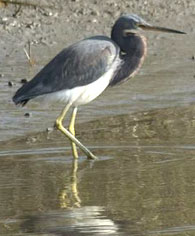 Guide: Sarah Ernst
Guide: Sarah Ernst
Locations: Mingo Point, the tomato fields between Freshfields and Cassique, Osprey Point, Willet Pond, Ocean Course driving range/lagoon/beach
Weather: Sunny, a little chilly in the morning but warmed up to 60s
Highlights: Another action-packed March morning of birding with 56 species! We started out at Osprey Point where the highlights included the nesting osprey and a brown thrasher singing his heart out at the top of the tree. Willet Pond held no more ducks, but to my surprise the first black-necked stilt of the season! The grassy area next to the driving range held the same mixed flock of savannah sparrows, common ground doves, house finches, cardinals, starlings, and a single song sparrow. Progressing closer to the lagoon we had an awesome close flyby by a young (under 2 years) bald eagle, the light hitting it well so we could see the golden highlights in its feathers and its massive beak. Later on we saw an adult bald eagle, but much further off. The lagoon was nearly empty other than some laughing gulls and a single greater yellowlegs, but the beach was PACKED with red knots and forster’s terns switching to breeding colors. And more Bonaparte’s gulls than I’ve ever seen in one spot. There may have been a least tern in there too but I lost it before I could be sure on ID, so I won’t count it. Most of our usual spring shorebirds were there – except no ruddy turnstones for some reason. Red-breasted mergansers were far off in the distance but we couldn’t find any ocean birds (loons, horned grebes)…but did see some dolphin while looking for ocean birds! Due to time we had to leave before we could thoroughly examine all the terns, gulls, and shorebirds for rarities, but we did get to finish off the trip with a piping plover.
Species: Red-breasted Merganser, Pied-billed Grebe, Double-crested Cormorant, Brown Pelican, Great Blue Heron, Great Egret, Tricolored Heron, Turkey Vulture, Osprey, Bald Eagle, Common Moorhen, American Coot, Black-bellied Plover, Wilson’s Plover, Semipalmated Plover, Piping Plover, American Oystercatcher, Black-necked Stilt, Greater Yellowlegs, Willet, Red Knot, Western Sandpiper, Least Sandpiper, Bonaparte’s Gull, Laughing Gull, Ring-billed Gull, Herring Gull, Forster’s Tern, Royal Tern, Mourning Dove, Common Ground Dove, Belted Kingfisher, Red-bellied Woodpecker, Yellow-bellied Sapsucker, Downy Woodpecker, American Crow, Fish Crow, Carolina Chickadee, Tufted Titmouse, Brown-headed Nuthatch, Carolina Wren, Blue-gray Gnatcatcher, Northern Mockingbird, Brown Thrasher, European Starling, Yellow-rumped Warbler, Savannah Sparrow, Song Sparrow, White-throated Sparrow, Northern Cardinal, Red-winged Blackbird, Common Grackle, Boat-tailed Grackle, House Finch
March 16, 2011 ~River Otters (Lutra canadensis)
 As we walked along the Ocean Course driving range lagoon on my most recent Back Island Birding trip, we observed several different animal tracks and scat. One of my guests asked me if the tracks he found were otter. Like many people who have had the good fortune to observe the North American River Otter in the wild, I find their adorable appearance and playful behavior utterly irresistible – they must tempt even the most serious scientist into cooing and giggling. So I tried not to let hopes cloud my judgment as I examined the tracks. Large mammal tracks on Kiawah may be one of many different species. Deer, raccoon, dog, and bobcat are the most commonly encountered. Otter, mink, opossum, coyote, fox, and house cat are much more rare but possible.
As we walked along the Ocean Course driving range lagoon on my most recent Back Island Birding trip, we observed several different animal tracks and scat. One of my guests asked me if the tracks he found were otter. Like many people who have had the good fortune to observe the North American River Otter in the wild, I find their adorable appearance and playful behavior utterly irresistible – they must tempt even the most serious scientist into cooing and giggling. So I tried not to let hopes cloud my judgment as I examined the tracks. Large mammal tracks on Kiawah may be one of many different species. Deer, raccoon, dog, and bobcat are the most commonly encountered. Otter, mink, opossum, coyote, fox, and house cat are much more rare but possible.
The first thing that struck me was the webbing clearly visible between the toes – and five toes, not four like members of the dog and cat family. When I stepped back I noticed the pattern of tracks – four paws together, then a gap, followed by four more paws, and so forth. Unlike all the other possible mammals which tend to walk, trot, or amble across the sand, members of the weasel family travel across land in a bounding, leaping motion. So considering those three traits, I was pretty sure it was a weasel. But which one: otter or mink?
I have seen mink tracks in the ocean course dunes and they are tiny – at only a few pounds in weight, minks are large in charisma but small in body and their paws are smaller than cat paws. Otters may not appear large at first glimpse but they are built like basset hounds – a long, heavy body on short legs. Their weight ranges from 11-30 pounds, which is also the weight range for a purebred Beagle, so they have the paws to match! These paws were definitely beagle-sized, not kitten-sized, and so I happily confirmed the identification of River Otter. Judging by their great condition and location below the high tide line, the otter must have been ahead of us by only a few hours!
By Sarah Ernst, Naturalist
March 15, 2011 ~ Feather Report
Guide: Sarah Ernst
Locations: Night Heron Pond, Blue Heron Pond Tower, Willet Island & Pond, The Ocean Course driving range/lagoon
Weather: Foggy all morning, wind along the marsh and beach, calm elsewhere
Highlights: We started out at the pond behind the nature center and were immediately given a show by pelicans diving in the pond for food. We also got a nice comparison between anhinga and cormorant. On Bubba’s pond we saw a bird that at first I took for a bird of prey, but proved to be a juvenile night heron with its bill tucked in its breast feathers…looking very annoyingly like a big buteo. There wasn’t much at the rest of the Preserve so we cut out of there and headed to the east end of the island. We were well rewarded there with wigeon still on the pond (no gadwall to be seen, at least from our angle), and parallel to the driving range a great flock of ground doves and a few mourning doves for comparison! They were also joined by house finches, cardinals, starlings, savannah sparrows, a few song sparrows, and yellow-rumped warblers. Further down the path a pair of loggerhead shrikes delighted us. The lagoon had a good assortment of shorebirds though it was a little too foggy to appreciate them. I did hear an unusual song from the dunes and was completely baffled until it was finally spotted on the dune ridge…a Wilson’s Plover! I didn’t know they could be so melodious. It later moved to the lagoon edge and we saw it in perfect light. We had to head back at that point due to running over time, but on our way back we spotted a male kestrel sitting on a tree, very well lit and looking both cute and beautiful at the same time as only kestrels can. The other unusual sighting of the day was a trio of hooded mergansers standing in the mud at the outlet for Willet Pond; I had never seen a merganser standing before, and was surprised by the amount of white on their bellies, both male and female.
Species: American Wigeon, Bufflehead, Hooded Merganser, Pied-billed Grebe, Brown Pelican, Double-crested Cormorant, Anhinga, Gerat Blue Heron, Great Egret, Snowy Egret, Little Blue Heron, Tricolored Heron, Black-crowned Night Heron, Osprey, Northern Harrier, Red-shouldered Hawk, Red-tailed Hawk, American Kestrel, Common Moorhen, American Coot, Wilson’s Plover, Semipalmated Plover, American Oystercatcher, Willet, Greater Yellowlegs, Lesser Yellowlegs, Ruddy Turnstone, Sanderling, Western Sandpiper, Least Sandpiper, Dunlin, Short-billed Dowitcher, Laughing Gull, Forster’s Tern, Mourning Dove, Common Ground Dove, Belted Kingfisher, Loggerhead Shrike, American Crow, Tree Swallow, Carolina Chickadee, Tufted Titmouse, Brown-headed Nuthatch, Eastern Bluebird, Northern Mockingbird, European Starling, Yellow-rumped Warbler, Pine Warbler, Savannah Sparrow, Song Sparrow, Northern Cardinal, Red-winged Blackbird, Common Grackle, House Finch
March 12, 2011 ~ Feather Report
Guide: Sarah Ernst
Locations: Mingo Point, the tomato fields between Freshfields and Cassique, Osprey Point, Willet Pond, Ocean Course driving range/lagoon/beach
Weather: Sunny, a little chilly in the morning but warmed up to 60s
Highlights: Special advanced edition of birding today, where we moved a little more quickly in search of more species. We started out at Mingo Point in search of the yellow-throated warblers and northern parulas I have heard singing there; no luck, but we did hear a blue-gray gnatcatcher, and saw a predictable assortment of marsh and forest birds. In search of a wood stork, we went on to the canal between Cassique and Freshfields…only a few great egrets there, but in the old tomato fields, we found a large flock of meadowlarks and large numbers of chipping sparrows, song sparrows, savannah sparrows, and a single field sparrow (that I could find, there were probably more!) We drove along the edge of the fields and found a red-shouldered hawk, anhinga, and the most surprising highlight of the day…a flock of at least sixteen wild turkeys. At Osprey Point we observed that the female in the cell phone tower nest had already started incubating while the one in the pine at the top of the driving range hadn’t yet begun. We also saw lots of bluebirds and of course alligators. Willet Pond still had a pair of gadwall and around 8 wigeon…both those ducks are fun to watch. The beach had both lesser and greater yellowlegs, a lovely pair of American oystercatchers in perfect light, and an assortment of 3000+ of beach birds out in the distance that we couldn’t spend too long on – too far off and not enough time! A quick scan of the ocean revealed a quartet of horned grebes and a single red-throated loon, but the surf was too rough for me to share my spotting so y’all will have to take my word for it. 🙂 At 68 species, I’m just a few shy of my Back Island Birding record for one morning (73 species last year)…also in March!
Species: Gadwall, American Wigeon, Scaup sp., Scoter sp., Bufflehead, Hooded Merganser, Wild Turkey, Red-throated Loon, Pied-billed Grebe, Horned Grebe, Double-crested Cormorant, Anhinga, Brown Pelican, Great Blue Heron, Great Egret, Snowy Egret, Little Blue Heron, Tricolored Heron, White Ibis, Turkey Vulture, Osprey, Red-shouldered Hawk, Common Moorhen, American Coot, Black-bellied Plover, Semiplamated Plover, Piping Plover, American Oystercatcher, Spotted Sandpiper, Willet, Greater Yellowlegs, Lesser Yellowlegs, Marbled Godwit, Ruddy Turnstone, Red Knot, Sanderling, Dunlin, Laughing Gull, Ring-billed Gull, Herring Gull, Forster’s Tern, Mourning Dove, Red-bellied Woodpecker, Downy Woodpecker, Northern Flicker, Pileated Woodpecker, Blue Jay, Fish Crow, American Crow, Carolina Chickadee, Tufted Titmouse, Brown-headed Nuthatch, Carolina Wren, Blue-gray Gnatcatcher, Gray Catbird, Northern Mockingbird, European Starling, Cedar Waxwing, Pine Warbler, Yellow-rumped Warbler, Chipping Sparrow, Field Sparrow, Savannah Sparrow, Song Sparrow, Northern dinal, Eastern Meadowlark, Common Grackle, House Finch
March 7, 2011 ~ Feather Report
Guide: Sarah Ernst
Locations: Night Heron Pond, The Preserve tower/trails, Willet Island, Falcon Point, Bass Pond
Weather: Sunny, some wind, low 60s
Highlights: Lots of osprey territorial and nesting behavior all over the place, including one at Falcon Point who was carrying a stick nearly as big as he was! Also at Falcon Point we saw a family of raccoons in the marsh, probably going for one of their favorite foods – fiddler crabs. We got a nice close look at a pine warbler at the Preserve – usually they’re singing at the tops of pine trees, not at eye level like this one – and a far less satisfying look at a skulky common yellowthroat in the marsh grass at Willet Pond. We flushed a pair of mergansers at Killdeer Pond but other than that, all the ducks have left.
Species: Hooded Merganser, Pied-billed Grebe, Double-crested Cormorant, Anhinga, Brown Pelican, Great Blue Heron, Great Egret, Tricolored Heron, Black-crowned Night Heron, Black Vulture, Turkey Vulture, Osprey, American Coot, Red-bellied Woodpecker, Downy Woodpecker, Blue Jay, Carolina Chickadee, Tufted Titmouse, Brown-headed Nuthatch, Carolina Wren, Ruby-crowned Kinglet, Blue-gray Gnatcatcher, Yellow-rumped Warbler, Pine Warbler, Common Yellowthroat, Song Sparrow, Northern Cardinal, Red-winged Blackbird, House Finch
By Sarah Ernst Naturalist
March 4, 2011 ~ Eastern Brown Pelican (Pelecanus occidentalis)
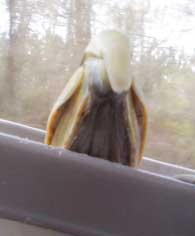 From time to time as I drove this injured young pelican to a wildlife rehabilitation clinic, the tip of its hooked beak would appear over the side of the bin. Remembering the accuracy with which a pelican can pinpoint a fish from the air and dive down to catch it with incredible accuracy – with as success rate as high as 80% – I felt a little nervous with my unpredictable passenger, but we both made it intact to the clinic. The pelican’s bill is one of the most fascinating inventions of the avian world, and uniquely adapted to catching fish, but the hook at the end has nothing to do fishing – it helps the pelican preen itself. And if you have to keep a seven foot wingspan in good condition, you’d better be an excellent preener.
From time to time as I drove this injured young pelican to a wildlife rehabilitation clinic, the tip of its hooked beak would appear over the side of the bin. Remembering the accuracy with which a pelican can pinpoint a fish from the air and dive down to catch it with incredible accuracy – with as success rate as high as 80% – I felt a little nervous with my unpredictable passenger, but we both made it intact to the clinic. The pelican’s bill is one of the most fascinating inventions of the avian world, and uniquely adapted to catching fish, but the hook at the end has nothing to do fishing – it helps the pelican preen itself. And if you have to keep a seven foot wingspan in good condition, you’d better be an excellent preener.
Our poor pelican, a brown-headed juvenile bird, was severely lacerated and shocked, though able to fly a little. Its injuries were substantial, so recovery would be a challenge, but we still have hopes. Interestingly, the pelican was banded, which may mean it was either a previous rehab patient or it was banded before it left its nest. We will submit its band number to find out where it came from before it crash landed onto Kiawah Island. Check in later for the report!
By Sarah Ernst Naturalist
March 2, 2011 ~ Feather Report
Town Biologists conducted our 4th winter bird banding session of 2011 today. They caught a total of 17 birds, representing 4 species, including 10 new birds and 7 recaptures. Yellow-rumped warblers (14) were the most common species. Three of the 5 recaptured Yellow-rumped warblers were originally banded last fall, 1 was banded in January 2011, and the other was banded in January 2010. To see their full report visit wildlifeatkiawah.com
February 27, 2011 ~ Calico Crab (Hepatus epheliticus)
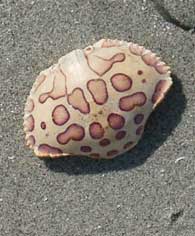 This vibrantly patterned shell belongs to the Calico Box Crab (Hepatus epheliticus). Their shells are fairly common on the beach and fresh specimens can be even more vibrantly colored, yet I have never seen a live one. Calico crabs live most of their lives underneath coastal waters, buried under the sand or mud below the waves, scavenging for whatever food materials they can find. Luckily for us, like all crabs they must molt their shell to grow. When the carapace (the “back” of a crab’s shell, pictured) becomes detached from the rest of the shell, it may wash up on the beach to be found by a lucky beachcomber. Remember if you go beachcombing on Kiawah that it is ok to take a special find or two home as a souvenir, but all those shells, sea stars, sand dollars, sponges, and other artifacts washed up on the beach play an important role in the island’s ecology, so most things should be left behind for other beach visitors to enjoy – both animal and human.
This vibrantly patterned shell belongs to the Calico Box Crab (Hepatus epheliticus). Their shells are fairly common on the beach and fresh specimens can be even more vibrantly colored, yet I have never seen a live one. Calico crabs live most of their lives underneath coastal waters, buried under the sand or mud below the waves, scavenging for whatever food materials they can find. Luckily for us, like all crabs they must molt their shell to grow. When the carapace (the “back” of a crab’s shell, pictured) becomes detached from the rest of the shell, it may wash up on the beach to be found by a lucky beachcomber. Remember if you go beachcombing on Kiawah that it is ok to take a special find or two home as a souvenir, but all those shells, sea stars, sand dollars, sponges, and other artifacts washed up on the beach play an important role in the island’s ecology, so most things should be left behind for other beach visitors to enjoy – both animal and human.
By Sarah Ernst, Naturalist
February 25, 2011 ~ Feather Report
Guide: Sarah Ernst
Locations: Osprey Point, Ocean Course Lagoon, Falcon Point & Bass Pond by van
Weather: Low 60s, cloudy, windy, rain began 2/3 of the way through the trip
Highlights: Given the wind, I decided to skip the marsh edges that I usually begin a trip with and head directly to Osprey Point. And luck was with us, because we had an amazing experience out there. We began by watching the female osprey on her cell phone tower nest. Then we headed down to the driving range and saw a male osprey on a tree with a fish in his talons. Once we got a good look at him through the scope, he took off (with the fish) and began his sky dance for us! We oohed and aahed at his swoops and curves through the sky, the whole time holding his fish and emitting the even, high-pitched whistles that I’ve only heard during this unique territorial/courtship display. But midway through the dance, an adult bald eagle came out of nowhere and dive-bombed the osprey! He took off towards the main road, with the eagle (and us) hurrying behind, and another three osprey joined the fuss! So I believe the four osprey represented one pair from nest on the cell phone tower as well as one pair from the big nest at the beginning of the driving range. Eventually they moved out of our sight, so we returned to the driving range to look at the immature red-tailed hawk that likes to sit in one of the nearby pine trees…and then the male osprey returned, sadly sans fish, and I think somewhat out of spite, he dive-bombed the red-tailed hawk and chased it well away from his nest.
We saw a few songbirds at Osprey and then headed straight to the Ocean Course to check out the giant red knot flock, but midway through hiking along the edge of the lagoon, it started to rain on us and continued for the rest of the trip. We did get a few shorebird species before it got too bad, but then the wind started blowing the rain very hard on us, so we hurried back to the van and continued the trip snug in the van.
Species: Hooded Merganser, Pied-billed Grebe, Double-crested Cormorant, Brown Pelican, Great Blue Heron, Great Egret, Snowy Egret, Little Blue Heron, Tricolored Heron, White Ibis, Osprey, Bald Eagle, Red-tailed Hawk, American Coot, Semipalmated Plover, Willet, Greater Yellowlegs, Ruddy Turnstone, Dunlin, Ring-billed Gull, Belted Kingfisher, Blue Jay, American Crow, Carolina Chickadee, Tufted Titmouse, Eastern Bluebird, Northern Mockingbird, European Starling, Yellow-rumped Warbler, Northern Cardinal, Red-winged Blackbird
February 23, 2011 ~ Feather Report, Birdsong
Spring is quickly arriving to Kiawah despite some brisk winds lately, and our year-round resident birds know it. This morning I heard many species singing at Mingo Point—cardinal, titmouse, chickadee, pine warbler, eastern bluebird, and house finch. And on my marsh kayaking trip, we observed a loggerhead shrike singing on a dead tree in the middle of the salt marsh! It was a great performance, though not as quite as musical as the cardinal or bluebird.
By Sarah Ernst, Naturalist
February 22, 2011 ~ Feather Report
Guide: Sarah Ernst
Locations: The Preserve, Osprey Point, Willet Island/Pond, Ocean Course driving range/lagoon/beach loop
Weather: Really warm but very strong winds
Highlights: Wind kept the songbirds down today thought we did our best at the Preserve and managed to pish up some chickadees, titmice, yellow-rumped warblers, and a downy woodpecker up to eye-level at the tower…it’s a nice change to look down or across to songbirds rather than up at them! We also got a nice close fly-by from a big female harrier. Osprey Point was also reluctant to give us many songbirds but delivered on raptors – we saw a pair of Osprey on their nest and an immature red-tailed hawk perched on a pine tree. It’s hard to tell whether they were incubating or not – the male kept fussing with some sticks, and the female appeared to be standing, not sitting. Willet Island and the driving range were quiet other than some bluebirds but once we passed the lagoon (which held some cute buffleheads) we hit lots of shorebirds – at least a thousand red knots, plus hundreds of semipalmated plovers, dunlin, and assorted other shorebirds. Back at Willet Pond we spied 10 gadwall, a puddle duck not often seen on Kiawah, and some female scaup. We’re on the tail end of duck season now but Willet, Ibis, and Bass Ponds still manage to give us some nice surprises.
Species: Gadwall, Lesser Scaup, Bufflehead, Red-breasted Merganser, Pied-billed Grebe, Double-crested Cormorant, Anhinga, Brown Pelican, Great Blue Heron, Great Egret, Snowy Egret, Turkey Vulture, Osprey, Bald Eagle, Northern Harrier, Red-tailed Hawk, American Coot, Semipalmated Plover, Killdeer, American Oystercatcher, Willet, Greater Yellowlegs, Ruddy Turnstone, Red Knot, Sanderling, Dunlin, Short-billed Dowitcher, Ring-billed Gull, Downy Woodpecker, Fish Crow, American Crow, Tree Swallow, Carolina Chickadee, Tufted Titmouse, Brown-headed Nuthatch, Carolina Wren, Eastern Bluebird, Northern Mockingbird, European Starling, Yellow-rumped Warbler, Pine Warbler, Savannah Sparrow, Northern Cardinal, Red-winged Blackbird, Common Grackle, Boat-tailed Grackle, House Finch
By Sarah Ernst, Naturalist
February 20, 2011 ~ Northern Cardinal (Cardinalis cardinalis)
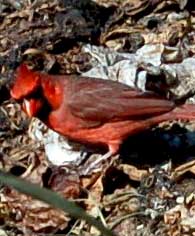 The compost pile at the Sanctuary has more benefits than just diverting food waste from the landfill. The heat generated by the rotting materials within the pile keeps insects active, providing easy meals for birds like this male Northern Cardinal. A few minutes spent scanning the area in the morning revealed an unusually high concentration of many different species of common songbirds, from song sparrows to yellow-rumped warblers. I will definitely return during spring migration to see if any unusual migrants follow the local residents to this source of “fast food”.
The compost pile at the Sanctuary has more benefits than just diverting food waste from the landfill. The heat generated by the rotting materials within the pile keeps insects active, providing easy meals for birds like this male Northern Cardinal. A few minutes spent scanning the area in the morning revealed an unusually high concentration of many different species of common songbirds, from song sparrows to yellow-rumped warblers. I will definitely return during spring migration to see if any unusual migrants follow the local residents to this source of “fast food”.
By Sarah Ernst, Naturalist
February 19, 2011 ~ Feather Report
Guide: William Oakley
Locations: Bass Pond, Osprey Point, Ibis Pond, Ocean Course beach (100 yard stretch by clubhouse)
Weather: warm and sunny with variable wind
Highlights: Across the street from Willet Pond, an immature Bald Eagle perched long enough for us to take photos and estimate its age (3-4yrs old). Foraging in the leaf litter near the parking lot of the Osprey Point Golf Course, a Hermit Thrush seemed undisturbed by our presence (and passing cars) and allowed close observation and multiple photos.
Species: Belted Kingfisher, Carolina Chickadee, Tufted Titmouse, Northern Cardinal, Fish Crow, American Crow, Blue Jay, Hermit Thrush, Eastern Bluebird, Carolina Wren, Swamp Sparrow, Yellow-rumped Warbler (Myrtle race), House Finch, European Starling, Royal Tern, Forster’s Tern, Herring Gull, Ring-billed Gull, Ruddy Turnstone, Sanderling, Willet, Brown Pelican, Double-crested Cormorant, Great Egret, Great Blue Heron, White Ibis, American Coot, Pied-billed Grebe, Hooded Merganser, Black Scoter, Lesser Scaup.
February 17, 2011 ~ Sea Whip (Leptogorgia virgulata)
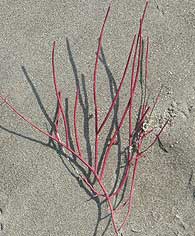 Out of all the animals we encounter on Pluff Mud Paddles and Ocean Seining, the sea whip is an organism whose appearance pushes many people’s definition of what it means to be an animal. It is a soft coral, made from a colony of translucent simple animals that grow together to form one single structure. The little polyps emerge to feed on plankton and like their distant jellyfish relatives, they do possess the capability to sting – thought not enough for a human to feel. A sturdy base anchors the sea whip to the ocean floor. The base splits into many branches which are made from a flexible, dark brown core called the axial rod, which you can see exposed in worn specimens. The axial rod is coated by a colorful, hard deposit that forms the little pores where the polyps live. A pretty impressive construction job by a team of animals without a single brain amongst them.
Out of all the animals we encounter on Pluff Mud Paddles and Ocean Seining, the sea whip is an organism whose appearance pushes many people’s definition of what it means to be an animal. It is a soft coral, made from a colony of translucent simple animals that grow together to form one single structure. The little polyps emerge to feed on plankton and like their distant jellyfish relatives, they do possess the capability to sting – thought not enough for a human to feel. A sturdy base anchors the sea whip to the ocean floor. The base splits into many branches which are made from a flexible, dark brown core called the axial rod, which you can see exposed in worn specimens. The axial rod is coated by a colorful, hard deposit that forms the little pores where the polyps live. A pretty impressive construction job by a team of animals without a single brain amongst them.
Our most common color is yellow but purples, oranges, and whites can also be found on occasion. All the colors are classified as one species, Leptogorgia virgulata. It has always annoyed me that I while I have been able to find out how the colors are formed – from tiny calcified plates called sclerites – I have never been able to discover whether the color morphs have a purpose in the world of a sea whip, or whether they’re a simply byproduct of another purpose, or completely without purpose at all. Nor whether the difference in color morphs is due to genetic factors, environmental factors, both, or neither. But that’s why I love being a naturalist – for every question answered, there are always a few dozen more questions waiting in the answer!
By Sarah Ernst, Naturalist
February 15, 2011 ~ bobcat (Lynx rufus)
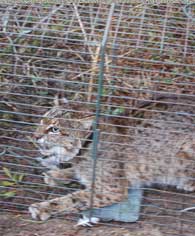 This female bobcat was caught as part of the town’s 2011 bobcat tracking study and released later in the evening after she had recovered from the sedative. Kiawah Island is famous for hosting a high concentration of bobcats compared to other developed barrier islands like Hilton Head, which has lost all or most of its bobcats. A few folks who learn of this program are concerned that they or their children are in danger of a bobcat attack, but unlike their far larger cousin the cougar/puma/mountain lion/catamount, there is not a single record across the United States of any unprovoked bobcat attack upon a human. As a general rule a bobcat will silently disappear from an approaching human’s path long before you see it, so there is no reason to fear this beautiful predator.
This female bobcat was caught as part of the town’s 2011 bobcat tracking study and released later in the evening after she had recovered from the sedative. Kiawah Island is famous for hosting a high concentration of bobcats compared to other developed barrier islands like Hilton Head, which has lost all or most of its bobcats. A few folks who learn of this program are concerned that they or their children are in danger of a bobcat attack, but unlike their far larger cousin the cougar/puma/mountain lion/catamount, there is not a single record across the United States of any unprovoked bobcat attack upon a human. As a general rule a bobcat will silently disappear from an approaching human’s path long before you see it, so there is no reason to fear this beautiful predator.
Our cats, though still very wild, are more acclimated to the presence of people than your average bobcat and if you want to see a bobcat in the wild, this is an excellent place to do it. Kiawah cats average around 15 to 25 lbs and prefer to feed on rodents and the occasional newborn fawn…but their strongly territorial nature makes them another excellent reason to keep your cat indoors. For more information on the bobcat tracking program, and to see the results from last year, visit www.wildlifeatkiawah.com
By Sarah Ernst, Naturalist
February 14, 2011 ~ Wolf spider (Hogna sp.)
 When you go for a walk through Kiawah’s maritime forest on a quiet February night, there seems to be very little life around you. But bring along a headlamp, or a flashlight held close to your eyes, and dozens of glowing green eyes from wolf spiders will reflect back at you from the forest floor. Wolf spiders are solitary hunters, ambushing and running down their prey rather than building a web to catch it. They run from very tiny to very large – the Carolina Wolf Spider, at as much as 4″ long. The idea of so many silent predators lurking around my toes was a little unnerving at first, but I have spent some time with my flashlight, watching them at close range, and most of the time they don’t realize I’m there. When they do, they tend to get nervous and back away. We enjoy the same woods together without one harming the other.
When you go for a walk through Kiawah’s maritime forest on a quiet February night, there seems to be very little life around you. But bring along a headlamp, or a flashlight held close to your eyes, and dozens of glowing green eyes from wolf spiders will reflect back at you from the forest floor. Wolf spiders are solitary hunters, ambushing and running down their prey rather than building a web to catch it. They run from very tiny to very large – the Carolina Wolf Spider, at as much as 4″ long. The idea of so many silent predators lurking around my toes was a little unnerving at first, but I have spent some time with my flashlight, watching them at close range, and most of the time they don’t realize I’m there. When they do, they tend to get nervous and back away. We enjoy the same woods together without one harming the other.
By Sarah Ernst, Naturalist
February 12, 2011 ~ Feather Report
Naturalist: Sarah Ernst
Tour: Shorebird Workshop
Locations: Ocean Course’s driving range lagoon/beach
Weather: Sunny, 40s-50s, low wind, pretty calm surf
Highlights: We began our shorebird workshop in the classroom meeting our neighborhood shorebirds in powerpoint format, then headed out to the beach to practice our identification skills on the real thing. We got a nice selection of shorebirds, nearly all the ones we were looking for. A young bald eagle also gave us a nice fly-by and some wading birds gave us relief from the challenge of the small, brown shorebirds. As we worked on looking through a flock of dunlin, both peep species, willets, and dowitchers, a falcon swooped by and spooked the entire flock, leaving only a single black-bellied plover seemingly ignorant of the fuss. Beyond the small breakers on the beach, we saw a couple of neat ocean birds, including a long-tailed duck and lots of horned grebes. There was also a bird that I thought might be a red-necked grebe…but I wasn’t completely confident it wasn’t a just a longer-billed, dull-colored horned grebe, so we won’t count it.. As I scanned through the ocean birds, a pair of oystercatchers delighted us by trotting right past us along the edge of the waves. We finished up the trip with a nice close look at a piping plover…which I conveniently found just after saying “This is perfect piping plover habitat”…if only that happened with black rails! The list below includes birds that we spotted en route as well as the shorebirds we concentrated on.
Species: Black Scoter 20+, Long-tailed Duck 1, Lesser Scaup 30+, Bufflehead 14, Hooded Merganser 2, Ruddy Duck 20+, Red-throated Loon 1, Pied-billed Grebe 3, Horned Grebe 15+, Double-crested Cormorant 3, Brown Pelican 7, Great Blue Heron 2, Great Egret 2, Snowy Egret 2, Little Blue Heron 3, Tricolored Heron 4, White Ibis 3, Wood Stork 1, Black Vulture 2, Osprey 1, Bald Eagle 1, Red-tailed Hawk 1, Falcon sp 1 (not sure Merlin vs Peregrine, still thinking!), Black-bellied Plover 2, Semipalmated Plover 1, Piping Plover 1, American Oystercatcher 2, Willet 20+, Greater Yellowlegs 5, Lesser Yellowlegs 1, Ruddy Turnstone 8, Western Sandpiper 100+, Least Sandpiper 20+, Dunlin 200+, Short-billed Dowitcher 30+, Ring-billed Gull 5, Herring Gull 1, Belted Kingfisher 1, American Crow 4, Sedge Wren 1, Northern Mockingbird 1, Yellow-rumped Warbler 20+, Savannah Sparrow 10+, Song Sparrow 1, Northern Cardinal 1, Red-winged Blackbird 30+, Common Grackle 20+, Boat-tailed Grackle 1
February 10, 2011 ~ River Otter (Lutra canadensis)
Today, from the comfort at his desk inside the Heron Park Nature Center, Scott Fister (Resort Sustainability Coordinator), watched a river otter emerge from the pond and scamper under the nature center.
Our town biologists report that a small numbers of river otter are present on Kiawah, living in both fresh and saltwater areas. Otters are 3-4 feet long and weigh between 12-25 pounds. An otter has short brownish-gray fur, webbed feet, and a long tail that is used as a rudder while swimming. Otters feed on a variety of aquatic animals, including: fish, snakes, turtles, frogs, and crayfish. They are most active at night but can be seen during the day as well.
February 9, 2011 ~ Redhead (Aythya americana)
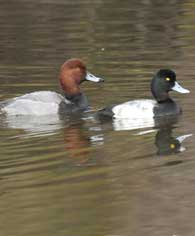 After viewing this photograph I was amazed by the similarities of the lesser scaup and redhead. Ducks are separated into two different groups depending on their feeding tactics: dabbling ducks and diving ducks. Dabbling ducks (mallards, teal, wood ducks, etc) feed on the surface of water or on land, or as deep as they can reach by up-ending without completely submerging. Diving ducks (typically heavier to enable more efficient diving but less efficient flying) dive deep underwater searching for small fish or invertebrates. Both the scaup and redhead are diving ducks that can be found in the ponds or out in the open ocean. The Lesser Scaup is the most abundant and widespread diving duck in North American and can often be found in flock made of hundreds of individuals on Kiawah. But pay close attention to details as they are nearly identical to the greater scaup (which is less common). This redhead is a very easily identified duck by the very distinctive red head. What a bute!
After viewing this photograph I was amazed by the similarities of the lesser scaup and redhead. Ducks are separated into two different groups depending on their feeding tactics: dabbling ducks and diving ducks. Dabbling ducks (mallards, teal, wood ducks, etc) feed on the surface of water or on land, or as deep as they can reach by up-ending without completely submerging. Diving ducks (typically heavier to enable more efficient diving but less efficient flying) dive deep underwater searching for small fish or invertebrates. Both the scaup and redhead are diving ducks that can be found in the ponds or out in the open ocean. The Lesser Scaup is the most abundant and widespread diving duck in North American and can often be found in flock made of hundreds of individuals on Kiawah. But pay close attention to details as they are nearly identical to the greater scaup (which is less common). This redhead is a very easily identified duck by the very distinctive red head. What a bute!
By Tim Pfifer, Naturalist
February 6, 2011 ~ Common Ground Dove (Columbina passerina)
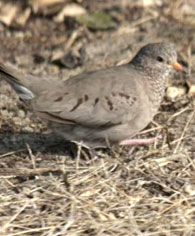 This common ground dove was photographed by visiting naturalist/photographer Sonya Vickers while back island birding. The Common Ground Dove is the smallest dove (sparrow size) in the US and can only be found in the south. They love open sandy areas with few trees and bushes which makes the vicinity of the Ocean Course driving range suitable habitat. As its name implies these doves nest, feed and live on the ground. Compared to our mourning dove this species is smaller, stocky with a very short tail and orange bill with a black tip. Flight is fast with short rapid wing beats much more like a quail than your typical dove. This is one of many great finds Sonya and I found during this December Back Island Birding!
This common ground dove was photographed by visiting naturalist/photographer Sonya Vickers while back island birding. The Common Ground Dove is the smallest dove (sparrow size) in the US and can only be found in the south. They love open sandy areas with few trees and bushes which makes the vicinity of the Ocean Course driving range suitable habitat. As its name implies these doves nest, feed and live on the ground. Compared to our mourning dove this species is smaller, stocky with a very short tail and orange bill with a black tip. Flight is fast with short rapid wing beats much more like a quail than your typical dove. This is one of many great finds Sonya and I found during this December Back Island Birding!
FYI: A group of doves can be called a “bevy, cote, dole, dule, or flight” of doves.
By Tim Pfifer, Naturalist
February 4, 2011 ~ Brown Pelican (Pelecanus occidentalis)
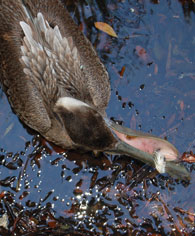 Immature brown pelicans have been congregating by the dozens on our residential and golf course ponds, taking advantage of cold-stunned fish. This individual was feeding on a fish that was at least on month dead, which made me redefine my image of a pelican’s diet. Pelicans are usually plunge-divers, scanning the water’s surface from the air, then diving underwater to capture fish with their extraordinary bill (capable of holding 2 gallons of water!). But apparently when it’s cold out, young pelicans are either lazy or hungry enough to go for less active prey.
Immature brown pelicans have been congregating by the dozens on our residential and golf course ponds, taking advantage of cold-stunned fish. This individual was feeding on a fish that was at least on month dead, which made me redefine my image of a pelican’s diet. Pelicans are usually plunge-divers, scanning the water’s surface from the air, then diving underwater to capture fish with their extraordinary bill (capable of holding 2 gallons of water!). But apparently when it’s cold out, young pelicans are either lazy or hungry enough to go for less active prey.
By Sarah Ernst, Naturalist
February 2, 2011 ~ White-tailed Deer (Odocoileus virginianus)
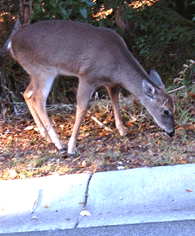 This buck has recently shed his antlers, but you can still see the scars where the antlers were attached. For all the deer on Kiawah (57 per square mile according to the January 2011 spotlight survey), you’d think you’d stumble across antlers all over the island. But antlers can be tricky to find, even in the right season. One of the reasons for that is their high value to other wildlife: squirrels, mice, and other wildlife will gnaw on deer antlers for a convenient calcium supplement. Antlers also are more likely to fall off where deer like to hang out, and that can mean some pretty inaccessible thickets.
This buck has recently shed his antlers, but you can still see the scars where the antlers were attached. For all the deer on Kiawah (57 per square mile according to the January 2011 spotlight survey), you’d think you’d stumble across antlers all over the island. But antlers can be tricky to find, even in the right season. One of the reasons for that is their high value to other wildlife: squirrels, mice, and other wildlife will gnaw on deer antlers for a convenient calcium supplement. Antlers also are more likely to fall off where deer like to hang out, and that can mean some pretty inaccessible thickets.
By Sarah Ernst, Naturalist
January 30, 2011 ~ Feather Report
Town Biologists report: :a Beach Patrol officer picked up a dead shorebird from the beach today. The bird was a red knot with a leg band and geolocator attached to it. This bird was captured and banded on September 2, 2009 on Monomoy Beach, Cape Cod, Massachusetts. The geolocator was returned to the researchers and they will be able to determine where this bird spent the last 14 months. Once the analysis is complete, town biologists will post details on their website: WildlifeatKiawah.com
January 28, 2011 ~ Downy Woodpecker (Picoides pubescens)
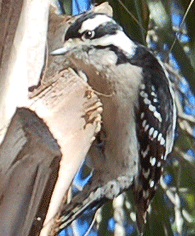 I found this female downy woodpecker searching for overwintering insects along the trunk of a palmetto tree. She didn’t mind my presence as I snapped off a dozen shots through my car window. Downies are our smallest woodpecker; the larger, longer-billed hairy woodpecker is an occasional visitor. Oddly enough, while hairy and downy woodpeckers are nearly identical in plumage, they are not closely related. Their resemblence is a case of covergent evolution – two species taking different routes over time to end up with a very similar appearance. Scientists have yet to discover why the flashy black and white pattern is such a good idea.
I found this female downy woodpecker searching for overwintering insects along the trunk of a palmetto tree. She didn’t mind my presence as I snapped off a dozen shots through my car window. Downies are our smallest woodpecker; the larger, longer-billed hairy woodpecker is an occasional visitor. Oddly enough, while hairy and downy woodpeckers are nearly identical in plumage, they are not closely related. Their resemblence is a case of covergent evolution – two species taking different routes over time to end up with a very similar appearance. Scientists have yet to discover why the flashy black and white pattern is such a good idea.
By Sarah Ernst, Naturalist
January 17, 2011 ~ Bufflehead (Bucephala albeola)
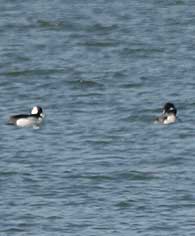 It has been a great season for waterfowl. Today, Town Biologists reported: 2 drake Green-winged teal were seen in Ibis Pond, 3 American Wigeon and 4 Redheads were seen in Willet Pond. 3 Long-tailed ducks, including 1 drake, were seen in the ocean near the Ocean Course Clubhouse. And, Kiawah Naturalists observed this male and female bufflehead off Mingo Point.
It has been a great season for waterfowl. Today, Town Biologists reported: 2 drake Green-winged teal were seen in Ibis Pond, 3 American Wigeon and 4 Redheads were seen in Willet Pond. 3 Long-tailed ducks, including 1 drake, were seen in the ocean near the Ocean Course Clubhouse. And, Kiawah Naturalists observed this male and female bufflehead off Mingo Point.
By Sarah Ernst, Naturalist
January 16, 2011 ~ Grey Sea Star (Luidia clathrata)
 Today, this unusual 4 armed sea star was found on Kiawah’s front beach by Anna McSwain from Marietta, GA! Thanks to her keen eyesight, I was able to observe this special echinoderm, as I have never before seen one like it before. This species of sea star is the most common found on the island, the Grey Sea Star, and typically will always have 5 arms.
Today, this unusual 4 armed sea star was found on Kiawah’s front beach by Anna McSwain from Marietta, GA! Thanks to her keen eyesight, I was able to observe this special echinoderm, as I have never before seen one like it before. This species of sea star is the most common found on the island, the Grey Sea Star, and typically will always have 5 arms.
Sea stars are fascinating creatures since they have the ability to liquefy and break off an arm (or two!) if the sea star is being preyed upon or threatened by another sea creature. Then, once the sea star is safe, it will regenerate the arm using specialized cells. Almost always, the sea star will regenerate, even if stressed or starving. This is why we may see sea stars on the beach with arms of all different lengths. It is even possible to find sea stars with 6 or more arms that result from an arm splitting when trying to regenerate! This arm dropping phenomenon however, is not what happened to this particular sea star. Since the arms here are almost perfectly equidistant, and no tears or scars are visible, it is most likely that this star never had a 5th arm. The most probable explanation for this anatomical mishap is a random genetic mutation. This star, for whatever reason experienced an imperfection in development which resulted in one less arm than usual. Mutations, however strange, are natural and are the base for such diversity in nature. Since we do not see 4 armed sea stars washing up frequently, we cannot blame this mutation on any environmental factor like pollution. This rare sea star was a treat to observe and research, and offered a great opportunity to play beachcombing CSI!
By Laura Willhoft, Naturalist
January 14, 2011 ~ Feather Report
Naturalist: Sarah Ernst
Tour: Back Island Birding
Locations: Turtle Pond, Bass Pond, Preserve (by van only), Ibis Pond, Willet Pond, Ocean Course clubhouse/driving range/beach loop
Weather: low 30s – low 40s, sunny and clear, very calm wind and surf.
Highlights: It was another awesome day of winter birding today, and particularly DUCK-TASTIC with 7 species of ducks, including 3 marked as “occasional” on our list! Turtle Pond was packed with mergansers and wading birds. We passed by Bass Pond and Killdeer Pond, but didn’t see much. Ibis Pond was home to a few dozen ruddy ducks and coots off in the distance. Kingfishers and wading birds were all over the place as we drove from location to location, and we saw a least 50 ibis at Willet Island. At first Willet Pond appeared empty but when we checked the other side, we found about 8 wigeon, 2 redhead, a few scaup, buffleheads, and more mergansers and coots. I had expected to see a redhead but the wigeon were a big (and pleasant) surprise. Both species were gorgeous. We also saw a pair of female harriers hunting over the marsh and a red-shouldered hawk perched up on a tree. As we watched the red-shouldered hawk, we heard a gator bellowing in the little retention pond…followed by another bellow further away! Never saw either, though. Along the tidal pond we saw a great assortment of shorebirds with hundreds of dunlin and a pair of piping plovers. On the beach we saw a pair of oystercatchers and yet more dunlin and misc shorebirds. As we headed back to the ocean course clubhouse, my sharp-eyed guests spotted a few birds on the calm ocean. The spotting scope revealed them to be a juvenile ring-billed gull, a pair of bufflehead and…a male long-tailed duck! This was a lifer for me! A pair of dolphins also delighted us as we turned back towards the clubhouse, which also happened to have a pair of bald eagles (one adult, one 1-2 year old) soaring overhead. What a day of birding!
Species: American Wigeon, Redhead, Lesser Scaup, Long-tailed Duck, Bufflehead, Hooded Merganser, Ruddy Duck, Pied-billed Grebe, Double-crested Cormorant, Brown Pelican, Great Blue Heron, Great Egret, Snowy Egret, Little Blue Heron, Tricolored Heron, Black-crowned Night Heron, White Ibis, Turkey Vulture, Bald Eagle, Northern Harrier, Red-shouldered Hawk, Clapper Rail, Common Moorhen, American Coot, Black-bellied Plover, Semipalmated Plover, Piping Plover, Killdeer, American Oystercatcher, Willet, Greater Yellowlegs, Ruddy Turnstone, Sanderling, Dunlin, Short-billed Dowitcher, Ring-billed Gull, Herring Gull, Belted Kingfisher, Yellow-bellied Sapsucker, Northern Flicker, Blue Jay, American Crow, Tree Swallow, Tufted Titmouse, Carolina Wren, Eastern Bluebird, Northern Mockingbird, European Starling, Yellow-rumped Warbler, Song Sparrow, Northern Cardinal, Red-winged Blackbird, Boat-tailed Grackle, House Finch
Janurary 9, 2011 ~ Black-crowned Night Heron (Nycticorax nycticorax)
 This juvenile black-crowned night heron was spotted recently on Kiawah. The night heron is a medium size and has a more robust build than other heron species. As an adult, they have white underparts, with a black head and back. The wings are a greyish color. The juvenile however, has striking orange eyes, and a light brown body with white spots. Night herons are most active at night, feeding around the brackish ponds on the island. They are more elusive than our other heron species, and although they are common on Kiawah, they are probably only seen when actively sought out. For the beginner birder, they may go unnoticed. Make sure to look around the edges of the ponds, you might just catch one perched in the surrounding trees and brush. To learn more about night herons and other native birds to the island, our back island birding tour is offered frequently!
This juvenile black-crowned night heron was spotted recently on Kiawah. The night heron is a medium size and has a more robust build than other heron species. As an adult, they have white underparts, with a black head and back. The wings are a greyish color. The juvenile however, has striking orange eyes, and a light brown body with white spots. Night herons are most active at night, feeding around the brackish ponds on the island. They are more elusive than our other heron species, and although they are common on Kiawah, they are probably only seen when actively sought out. For the beginner birder, they may go unnoticed. Make sure to look around the edges of the ponds, you might just catch one perched in the surrounding trees and brush. To learn more about night herons and other native birds to the island, our back island birding tour is offered frequently!
By Laura Willhoft, Naturalist
January 6, 2011~ Feather Report (2010 Nest Box Report)
The venerated Captain Bluebird of Kiawah, Bill Blizard, has compiled his 2010 report on the bluebird nest boxes of Kiawah. In general it was a good year for our Eastern Bluebirds – better than 2009, but not as high as 2008. Out of 147 bluebird nests, 721 eggs were laid and approximately 649 baby bluebirds made it to fledgling stage. While there is a naturally high mortality rates in fledglings and young birds, we can still expect a great deal of new bluebirds in the skies this year. Additionally, 274 Carolina Chickadees and 8 Carolina Wrens were produced. And in a first this year, a pair of Great Crested Flycatcher babies hatched and fledged. Like bluebirds, Great Crested Flycatchers are cavity nesters and will use a human-made nest box, though they usually prefer higher locations.
January 3, 2011 ~ Cooper’s Hawk (Accipiter cooperii)
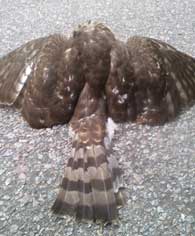 This immature Cooper’s hawk was struck by a car on Governor’s Drive. We picked it up alive thanks to the calls of passing walkers, but sadly the bird died before it could receive medical attention. Cooper’s hawks are fast, agile fliers that specialize in streaking through the forest after their main prey: smaller birds. And that’s often how we see them on Back Island Birding tours – a quick burst of feathers through the trees. Sadly, this habit makes Cooper’s hawks, owls, and other forest-hunters vulnerable to car strikes as they tear across a road, mind focused only on a potential meal. There’s not much we drivers can do other than keeping to the posted speed and staying alert. Cooper’s Hawks are common across much of North America and while I regretted the loss of the individual bird, I was delighted to get the chance to take an up-close look at its needle-sharp talons, subtle plumage, and fierce yellow eyes.
This immature Cooper’s hawk was struck by a car on Governor’s Drive. We picked it up alive thanks to the calls of passing walkers, but sadly the bird died before it could receive medical attention. Cooper’s hawks are fast, agile fliers that specialize in streaking through the forest after their main prey: smaller birds. And that’s often how we see them on Back Island Birding tours – a quick burst of feathers through the trees. Sadly, this habit makes Cooper’s hawks, owls, and other forest-hunters vulnerable to car strikes as they tear across a road, mind focused only on a potential meal. There’s not much we drivers can do other than keeping to the posted speed and staying alert. Cooper’s Hawks are common across much of North America and while I regretted the loss of the individual bird, I was delighted to get the chance to take an up-close look at its needle-sharp talons, subtle plumage, and fierce yellow eyes.
Sarah Ernst, Naturalist